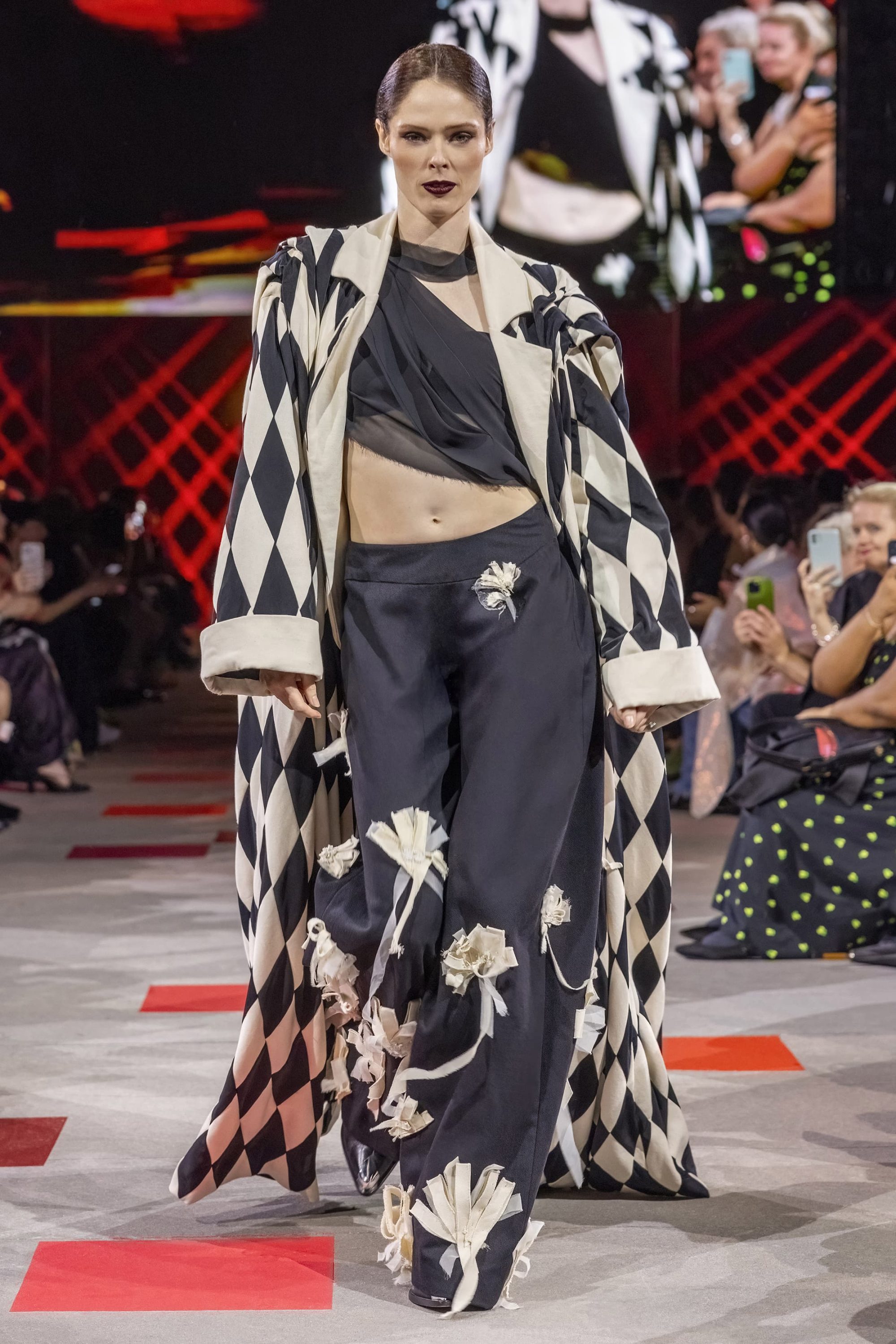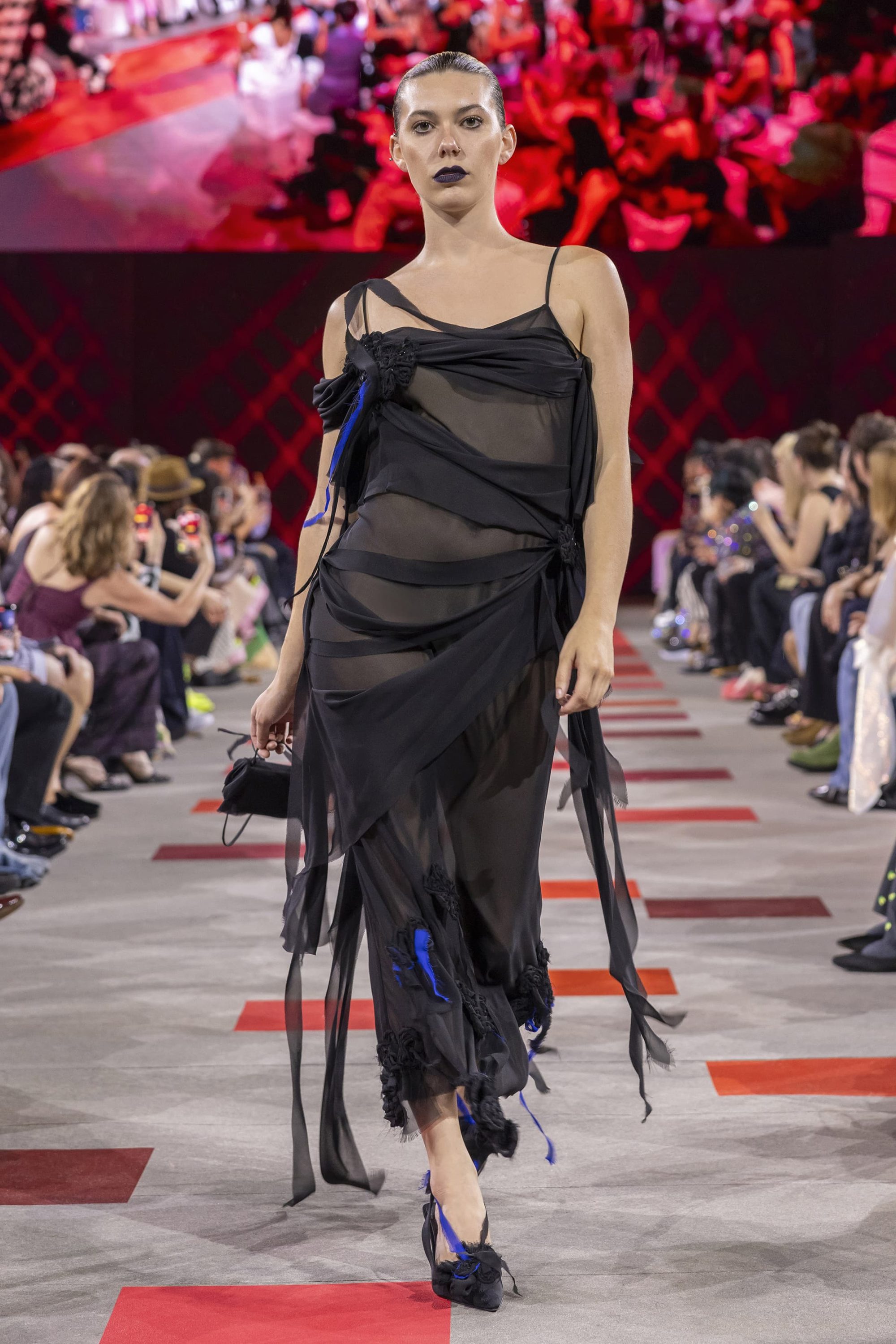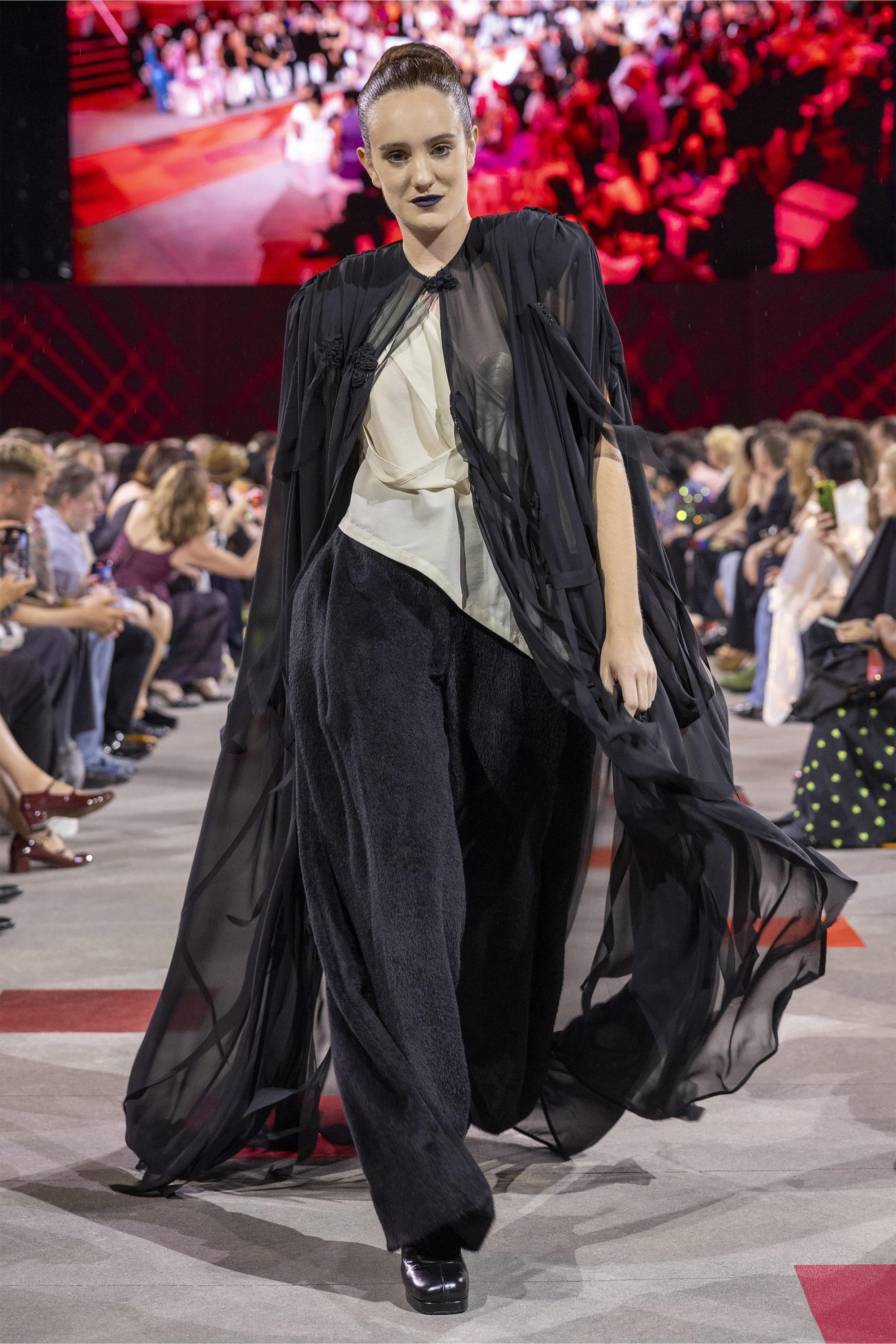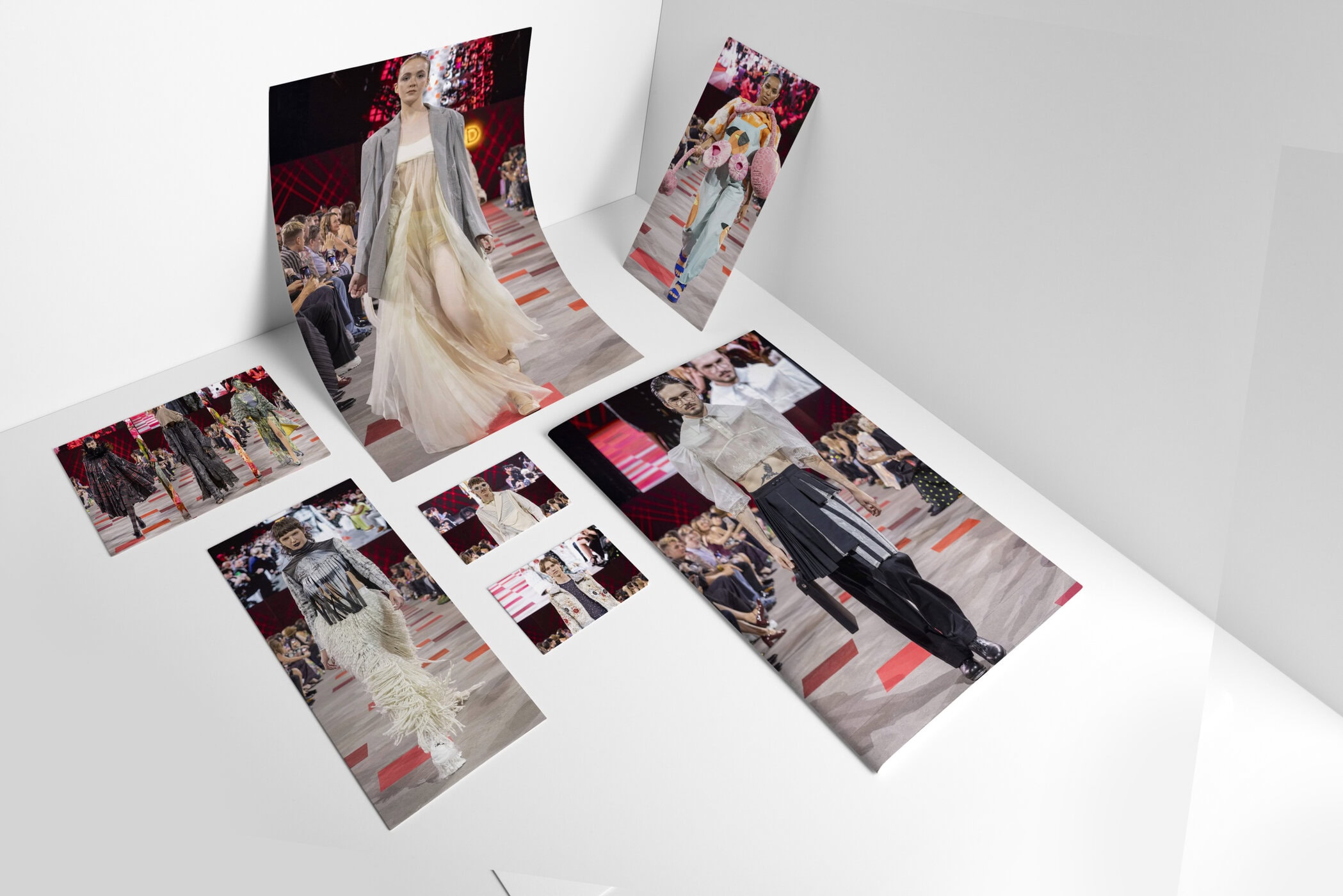From Concept to Couture: Highlights from SCAD Fashion 2024
By Mackenzie Richard
In May, the annual SCAD Fashion show celebrated the innovative and inspiring work of the next generation of fashion designers from the Savannah College of Art and Design. Carefully selected for this prestigious presentation, these talented students showcased collections that not only captivated the audience but also demonstrated their unique perspectives and creative prowess.
We had the pleasure of speaking with some of these budding designers to delve deeper into their creative processes. We asked them two key questions: What was the primary inspiration behind your latest collection, and how did you translate this inspiration into your designs? Additionally, we explored the core elements of their brand DNA, seeking to uncover the unique aspects that define their design aesthetic and set their brands apart in the ever-evolving fashion industry.
The SCAD campus is a testament to the institution’s commitment to fostering creativity and innovation. With state-of-the-art equipment and a faculty that expertly blends industry knowledge with a passion for nurturing young talent, it is clear that these students are well-equipped and empowered to succeed. After spending mere moments on the campus and seeing the facilities, it’s evident that SCAD provides an environment where students are enabled to push boundaries and bring their artistic visions to life.
The students drew inspiration from a diverse range of sources, including personal experiences, historical eras, natural phenomena, and cultural heritage. Their collections featured unique textile manipulations, innovative prints, and striking silhouettes that pushed the boundaries of traditional fashion design. Each designer showcased a distinct aesthetic, reflecting their individual brand DNA and offering a fresh perspective on contemporary fashion.
From exploring the ethereal and eerie, to fusing historical aesthetics with modern technology, to challenging traditional menswear norms, these young designers demonstrated a profound understanding of both conceptual and practical aspects of fashion design. Their work not only highlights their creativity and technical skills but also their ability to convey deep and personal narratives through their designs.
Join us as we highlight the journeys and visionary talents of these remarkable young creatives, who are poised to make significant contributions to the fashion world.
Index
Featuring: Alexa Wexler, Rakee Chen, Sammy Baker, Joey Yelenoc, (King) Xiaotong Wang, Isabelle Ferrugia, Marky Bergeron, Lauren Mika, (Phoebe) Wei Chun Sun, Chuck Ryan, Maggie Foster, Richenelle Isip, Kagan McCurnin and Andrea Rios
Alexa Wexler
What was the primary inspiration behind your latest collection, and how did you translate this inspiration into your designs?
My primary inspiration for my collection is my personal relationship with sleep paralysis. If you are unaware of what sleep paralysis is, it occurs when you’re asleep and your body will enter a paralysis-like state, meaning you can’t move. In which you can experience hallucinations/ visions where you can see things around you which are not actually present. What I would see was often a tall white faceless figure standing in the corner of my room, it would appear to be hovering off the ground and would begin to slowly approach me. Sometimes there would be a couple or just one or none. At first I was very scared and intimidated as I began to experience this more frequently I began to become less scared and almost curious. I decided to make these experiences the soul inspiration for my collection including a feeling of being watching, with the face I cyanotype printed onto cheesecloth providing an eerie feeling almost paranoia-like. All of the textile manipulations, including my plaster jacket made from an old paint drop cloth, my puffed cowhide leather skirt and the big yarn like coats and skirts all derived from an ethereal feeling and my sleep paralysis muse.
Can you describe the core elements of your brand DNA? What unique aspects define your design aesthetic and differentiate your brand from others?
The core elements of my brand DNA are just really being different. Clothes can be so many things, protective gear, fashion accessories, a statement, an heirloom and maybe even a mask. I want people to be comfortable in their own skin in whatever way they please and let it be known that it’s okay and even welcome if it might be something a little unhinged.
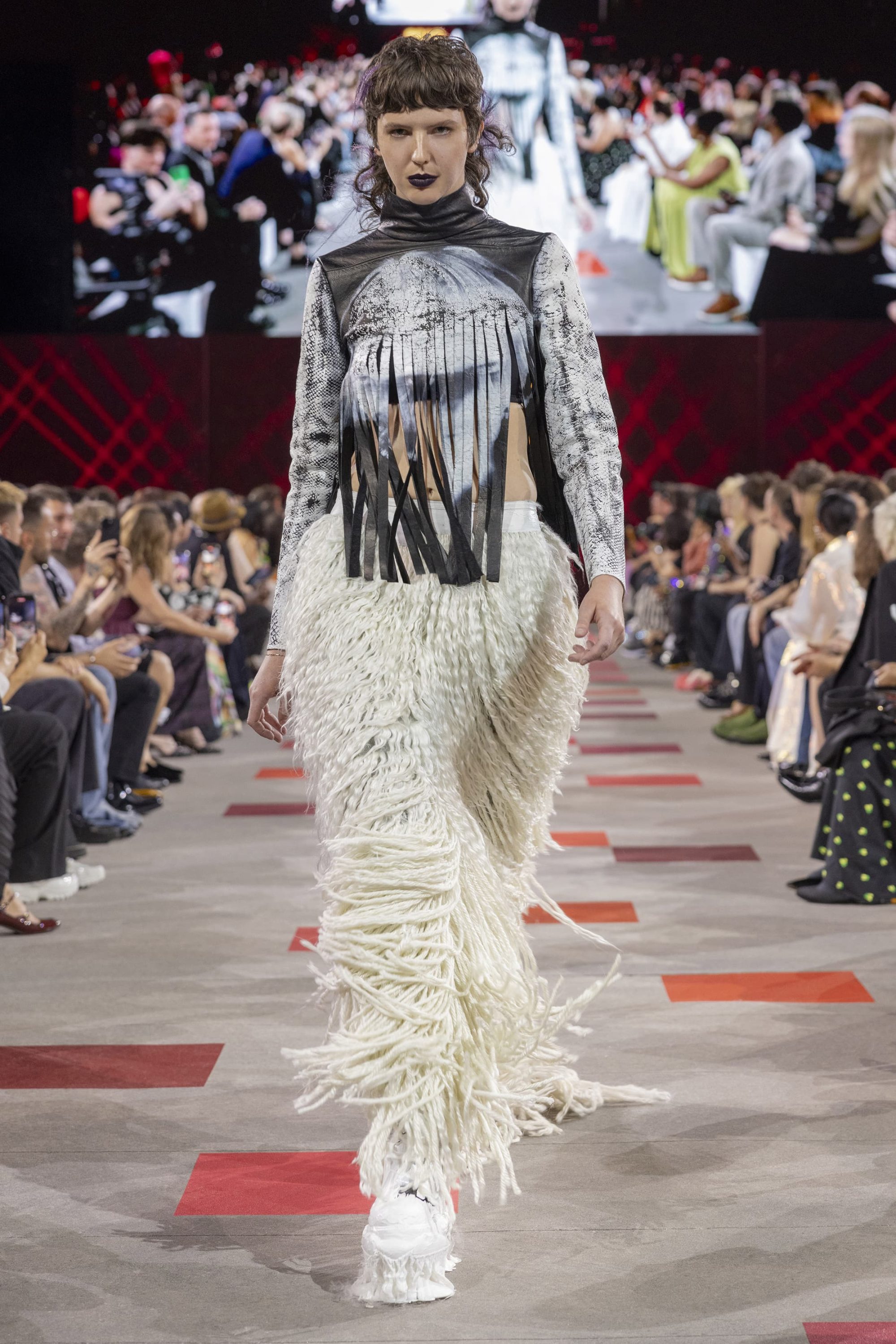
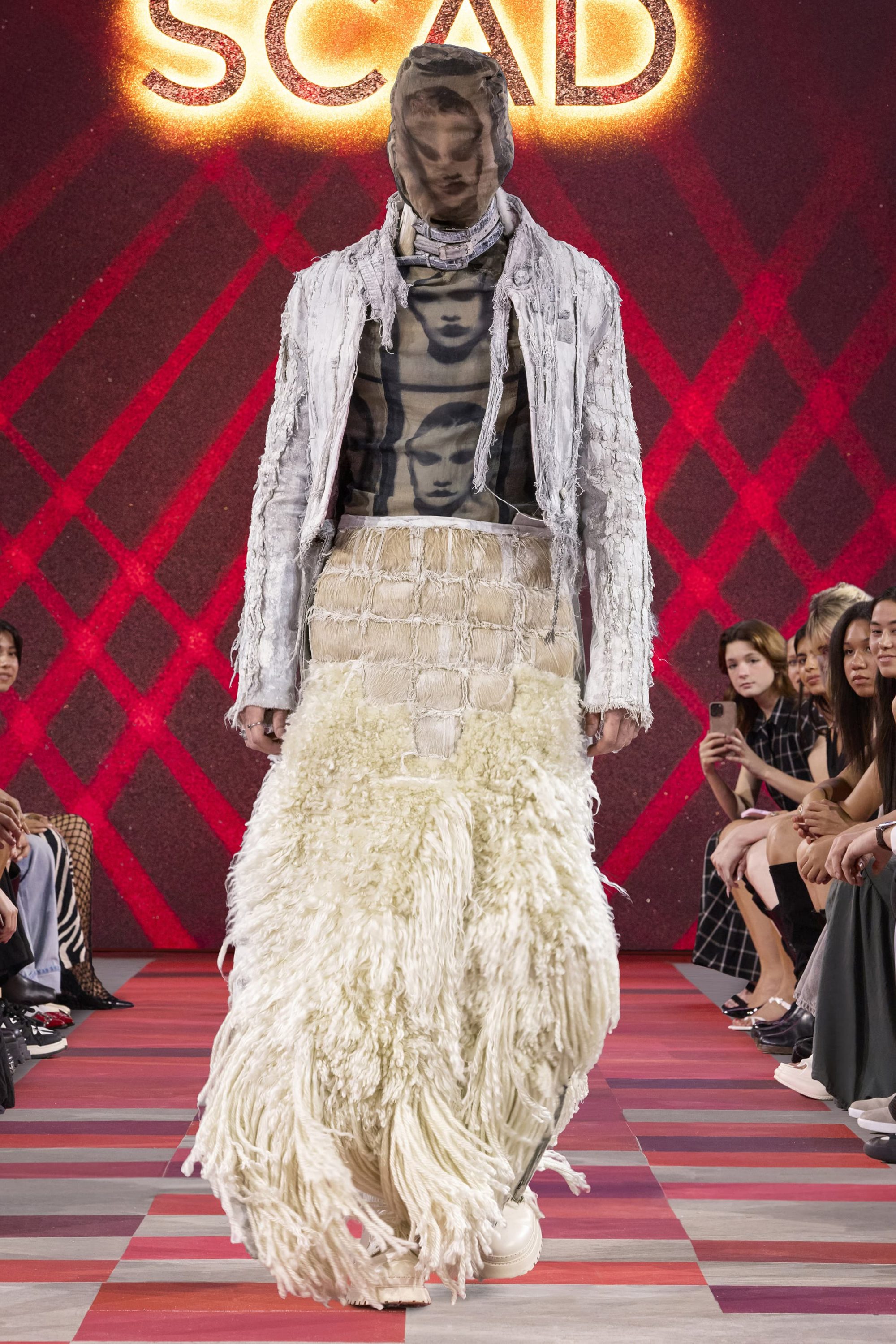
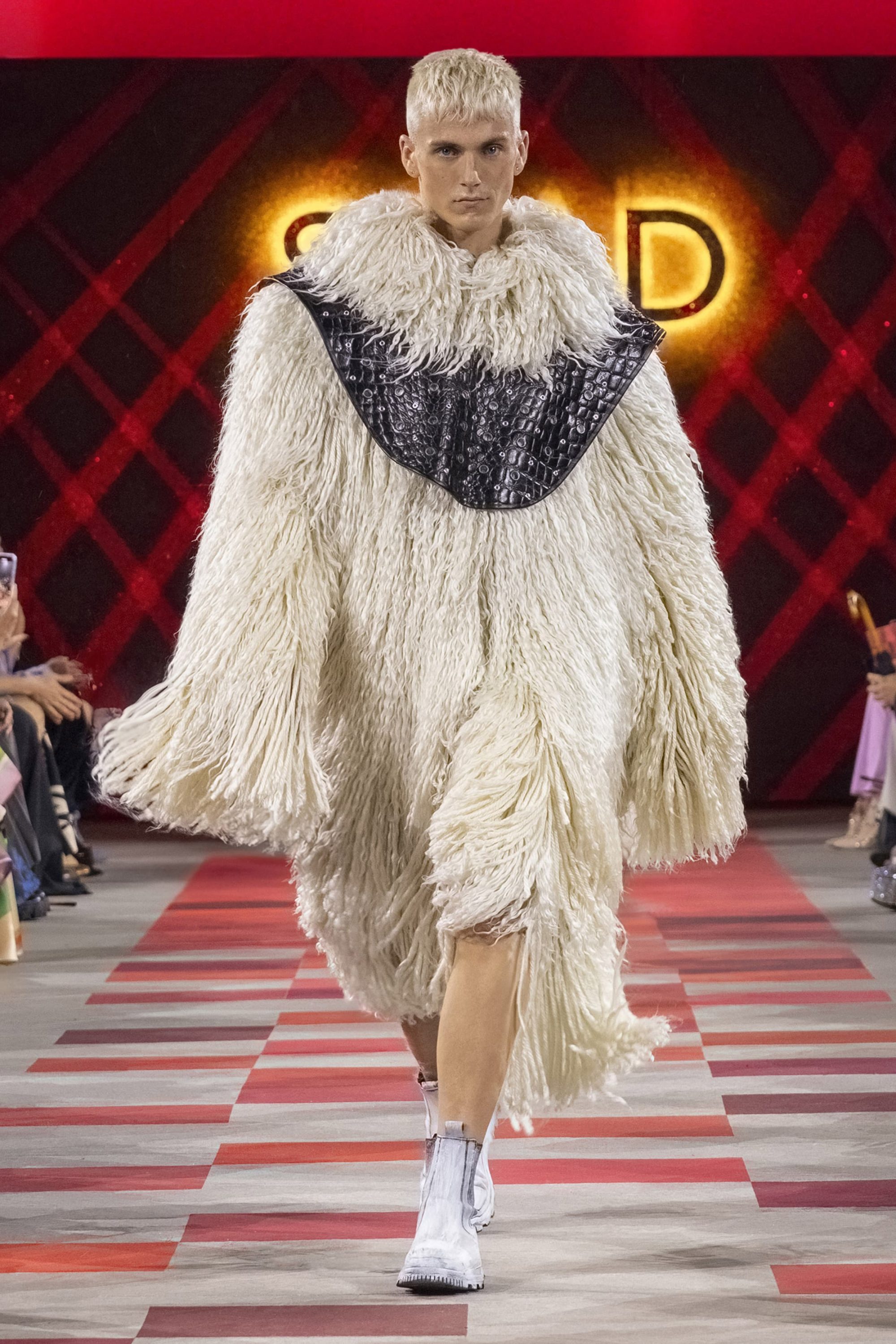
Rakee Chen
What was the primary inspiration behind your latest collection, and how did you translate this inspiration into your designs?
My collection, “The Era,” is inspired by the combination of Renaissance aesthetics and electronic music. I created a music program to visualize sound, which led to unique prints in my designs. I wanted to combine technology with fashion and this collection merges the beauty of the past with the innovation of the present.
Can you describe the core elements of your brand DNA? What unique aspects define your design aesthetic and differentiate your brand from others?
Color and texture. My unique prints tell a musical story, where each sound translates into a different visual effect, enriching the colors in my designs. I’m still exploring my design style; “The Era” is elegant and conceptual. However, another streetwear brand I am working on, @SCHNABBIT, is quirky and youthful. I also design shoes and accessories, embracing a wide range of creative expressions. This approach allows me to remain unrestricted and continually discover a cohesive identity through my diverse works.
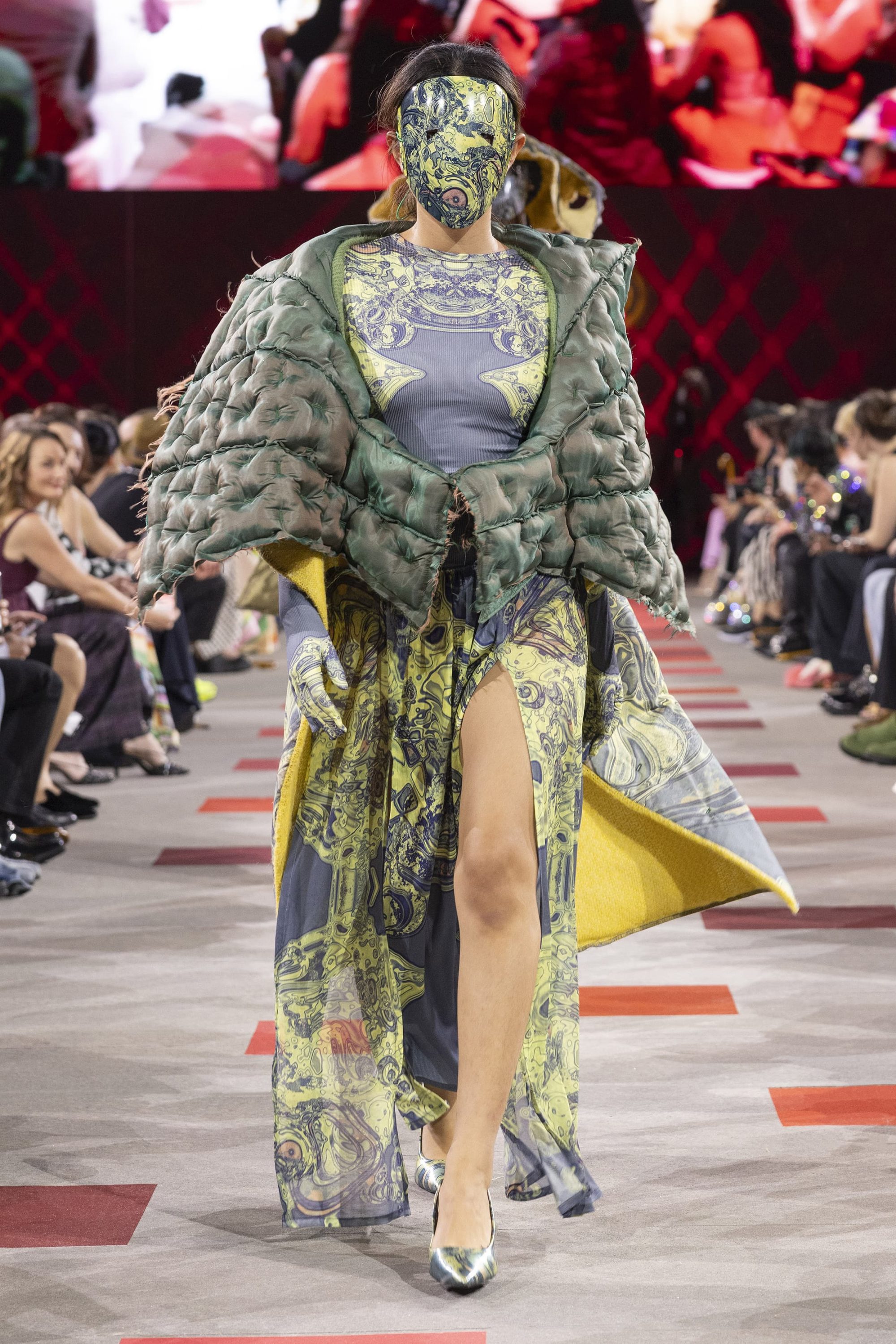
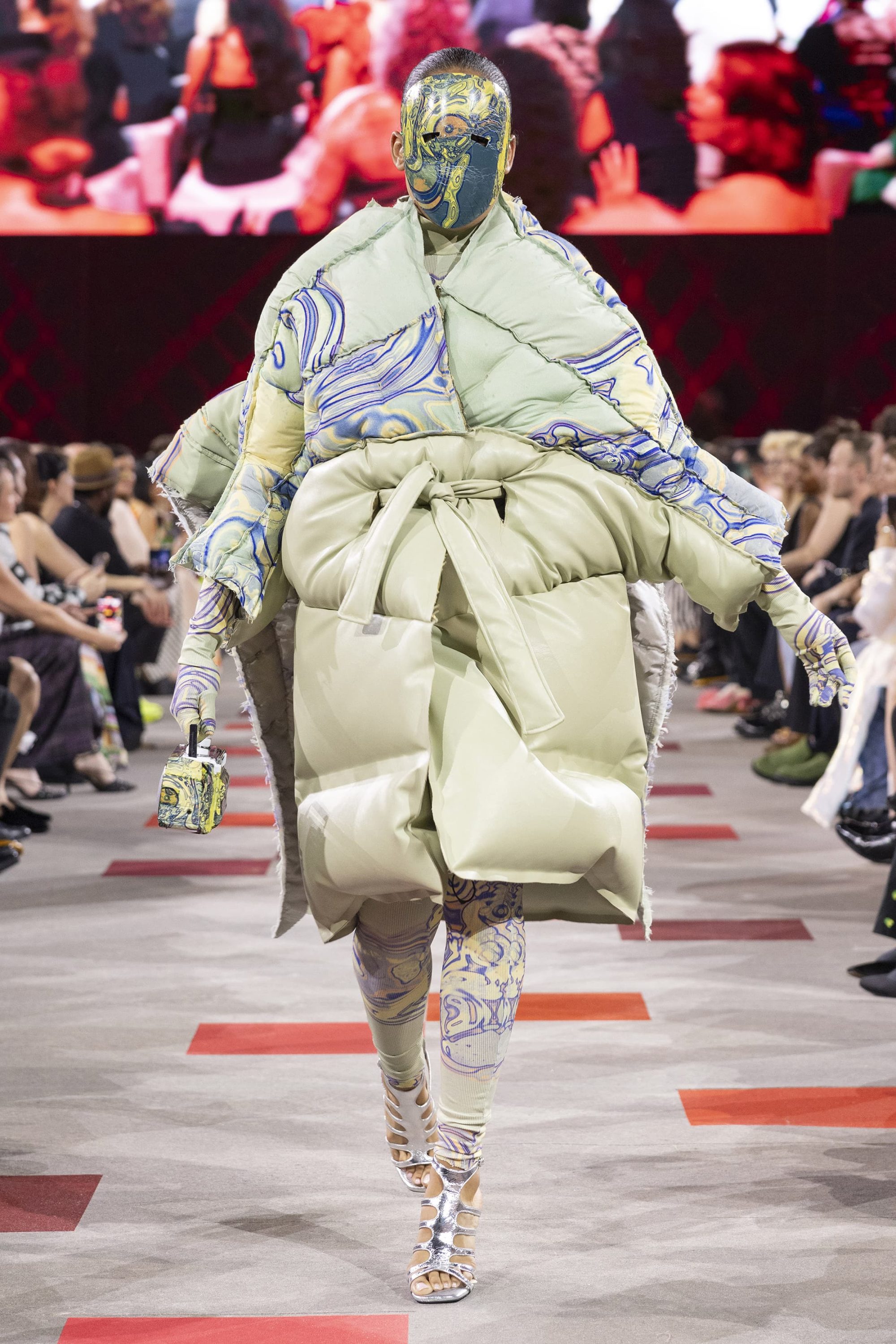
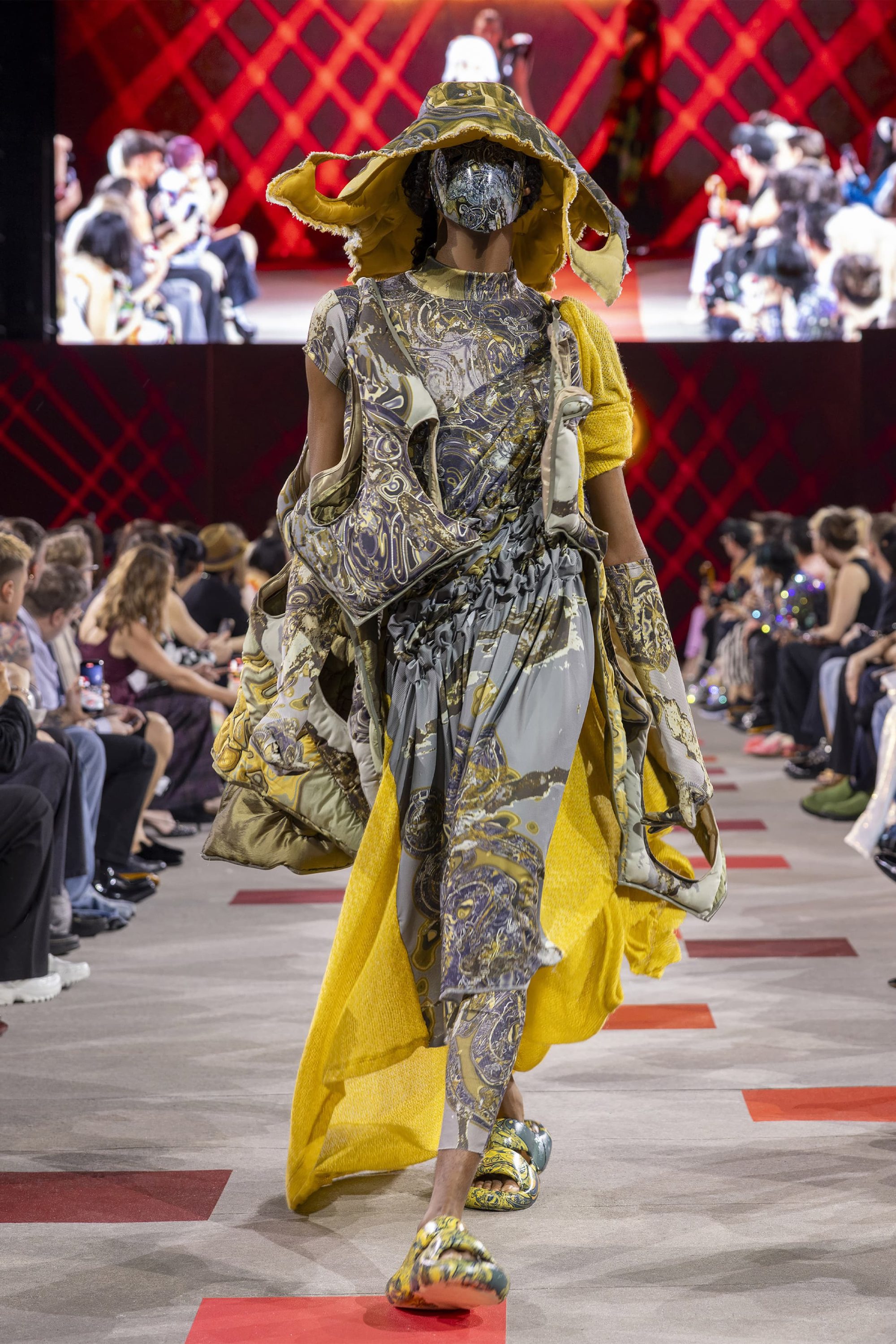
Sammy Baker
What was the primary inspiration behind your latest collection, and how did you translate this inspiration into your designs?
My collection “Monster in You” is inspired by the natural and artificial environment we live in, as well as the instinctual energies of our human nature. We are these emotionally complex creatures that take in our surroundings in a way that’s specific to each of us individually. Whether we’re dancing to music, getting dressed in the morning or rhythmically walking down the street our energy extends past our physical form, a feeling that only we can experience.
Monster in you translates this through exaggerated features and silhouettes that act as an expressive extension of self. For example, five foot sleeves, wool spikes and overlapping frayed denim describe your mysterious and beautiful complexities without saying a single word. Taking a feeling and turning it into visual communication, for the force of nature that you are.
Can you describe the core elements of your brand DNA? What unique aspects define your design aesthetic and differentiate your brand from others?
Utilizing upcycled materials within my designs is a strong way of making a piece unique, allowing it to appear as if it’s had a life of its own. Like a lot of people I collect things, but one of my favorite things to collect is objects I find in grass and gravel. Where some might see trash I see stories through bright colored plastic and earth textured paper.
Throughout my designs are these collages of found items, plastic fruit bags, scrap fabrics and buttons. The found aspect of my work makes every detail so special because it is specific to the environment it came from. I am hopeful as a designer that my work reminds people of fashion as a form of personal communication, and welcomes them to share how they feel through modifying their clothes to reflect their own environment.
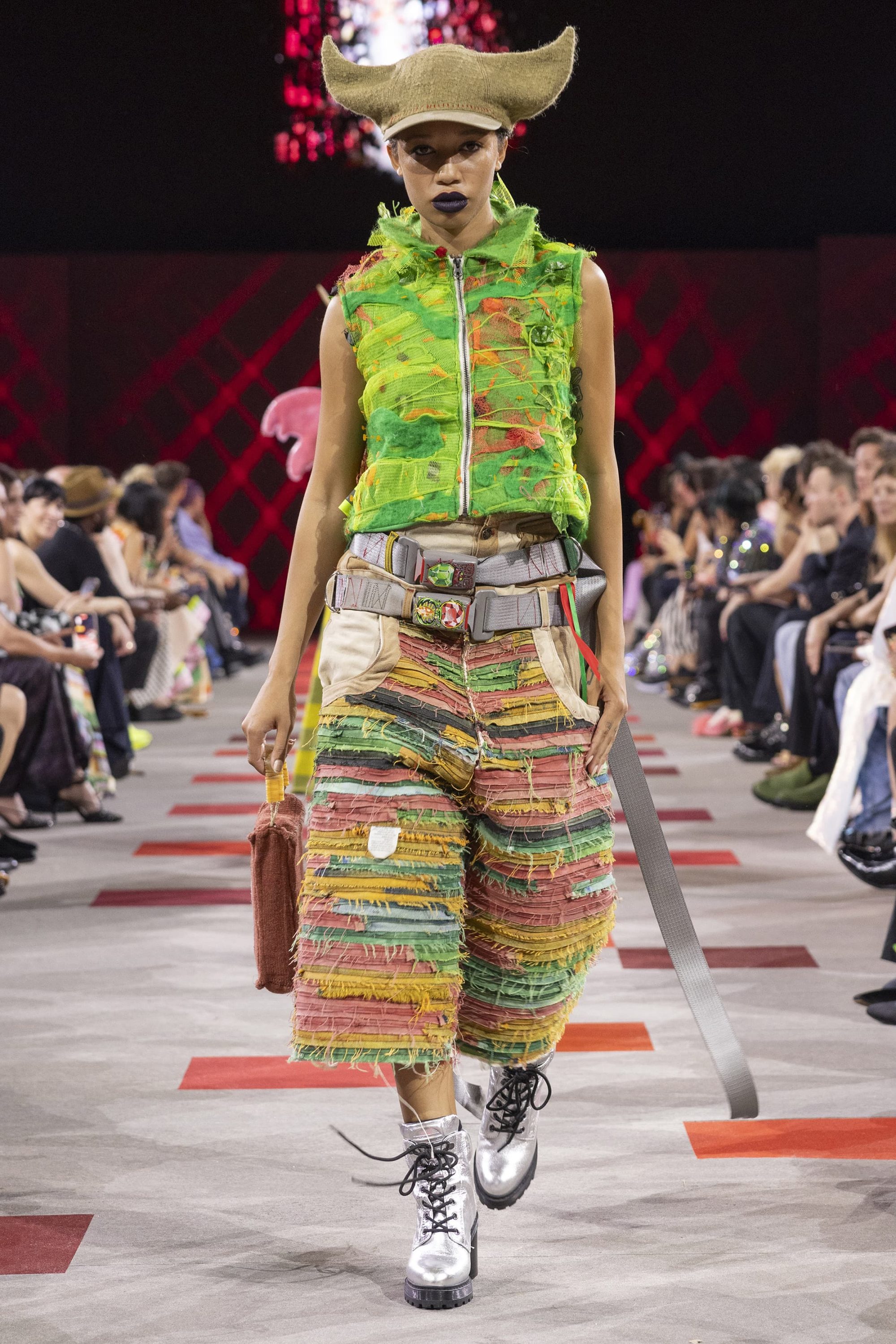
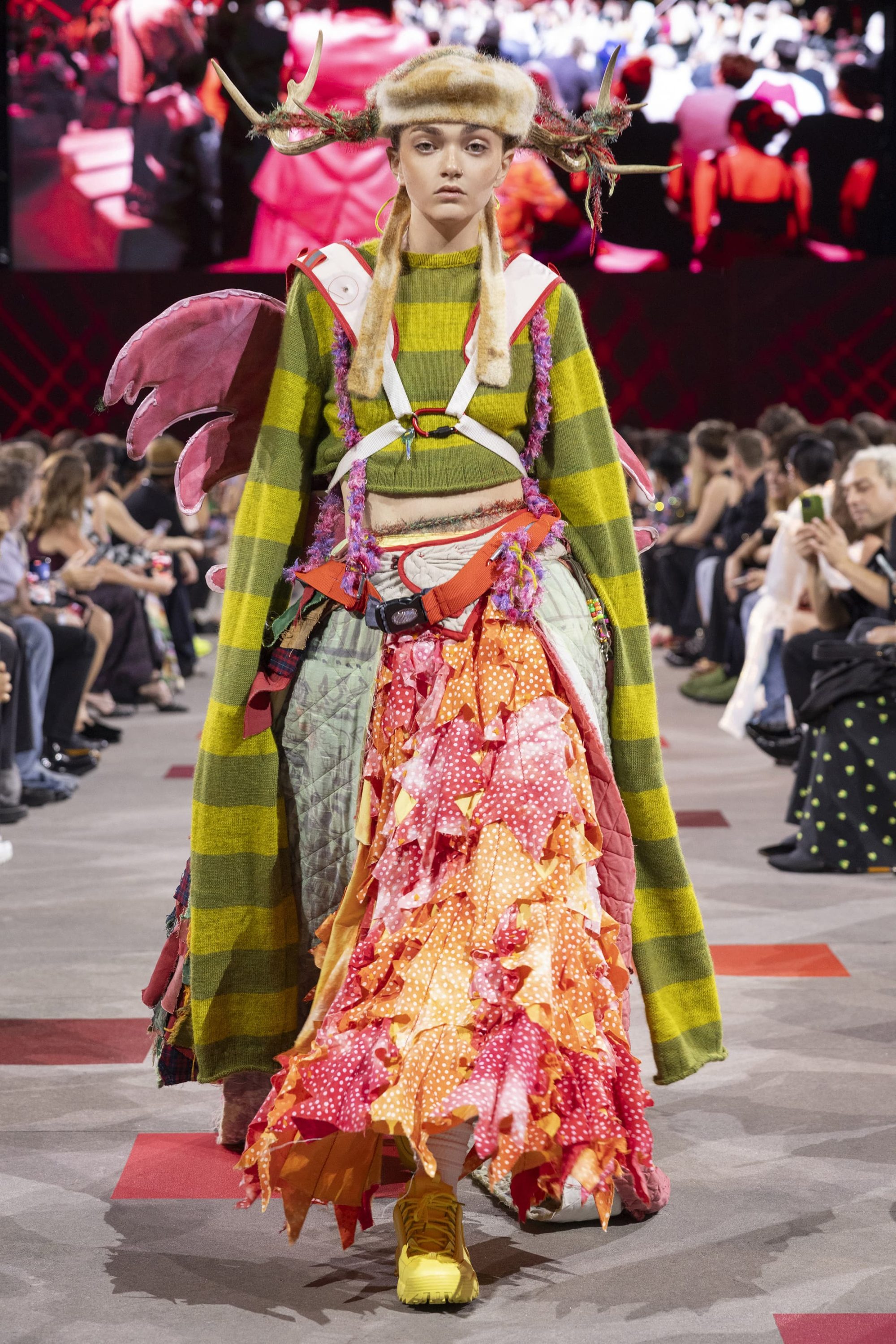
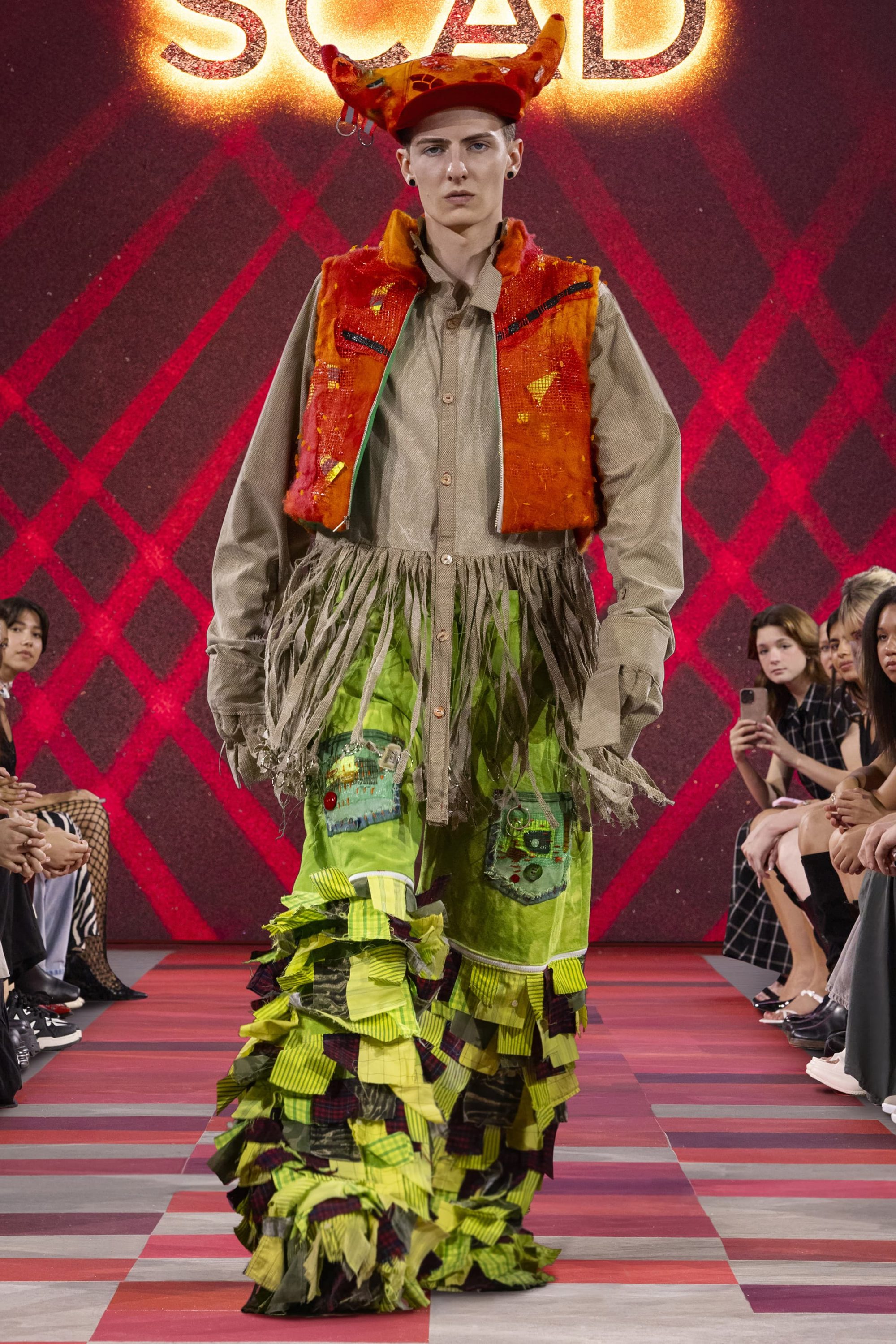
Joey Yelenoc
What was the primary inspiration behind your latest collection, and how did you translate this inspiration into your designs?
At its core, my collection offers viewers a glimpse into my envisioned post-apocalyptic world. Inspired by the desolation of Andrei Tarkovsky’s films, the chaos of decay and ink, the raw irregular forms of Russian and Serbian monuments, and my upbringing exploring the woods of Pennsylvania. The found objects, worn fabric, and unconventional materials question the purpose of traditional fashion and consumption.
To translate this inspiration into my designs I focused on world-building and found objects, the chosen material for each look reflects the image of the world it would be found within. Through this process, I encouraged viewers to envision the world in which the characters inhabit by just looking at the clothing they wear.
Can you describe the core elements of your brand DNA? What unique aspects define your design aesthetic and differentiate your brand from others?
I think I have an immersive approach to fashion with a focus beyond the attire on world-building. Sight, sound, smell, movement, character personality, and the roles within the group were all considerations in creating this lineup. Drawing inspiration from video games, film, architecture, and raw textures, the references I lean on are unique and play a huge role in my creative vision. By integrating immersion, graphic design, and primary research exploring obscure antique shops and barns, I intend to build a fuller narrative surrounding my creations.
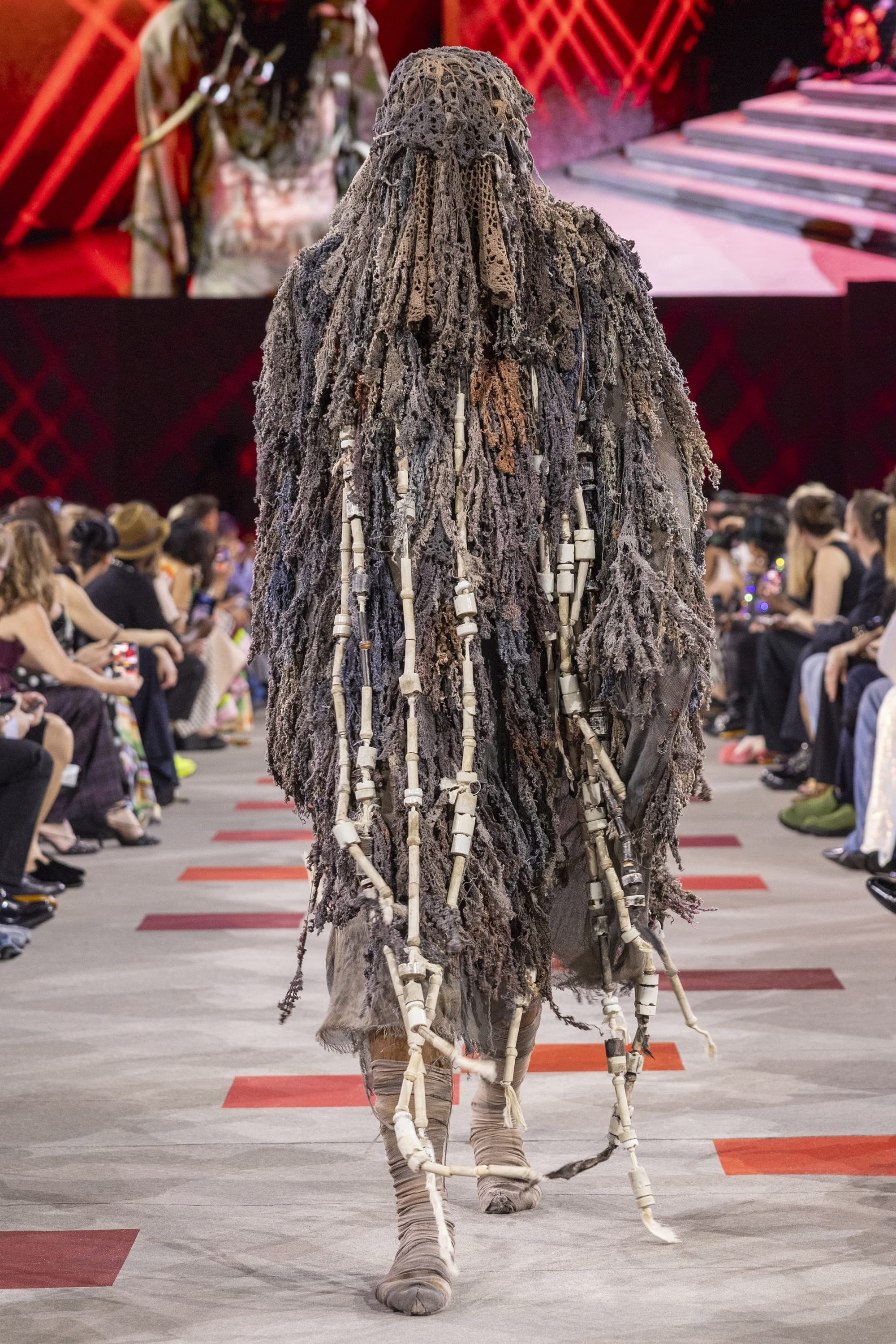
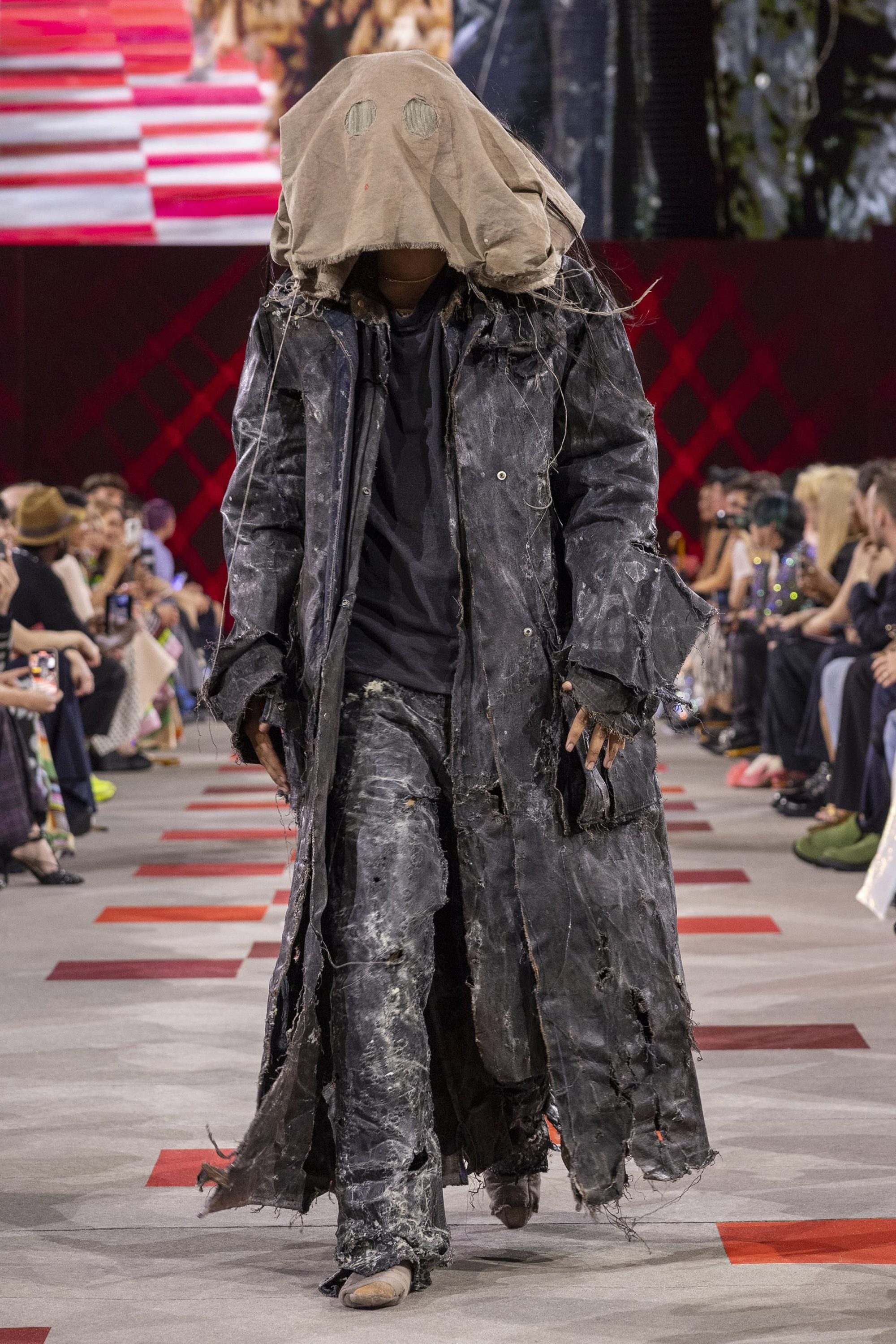
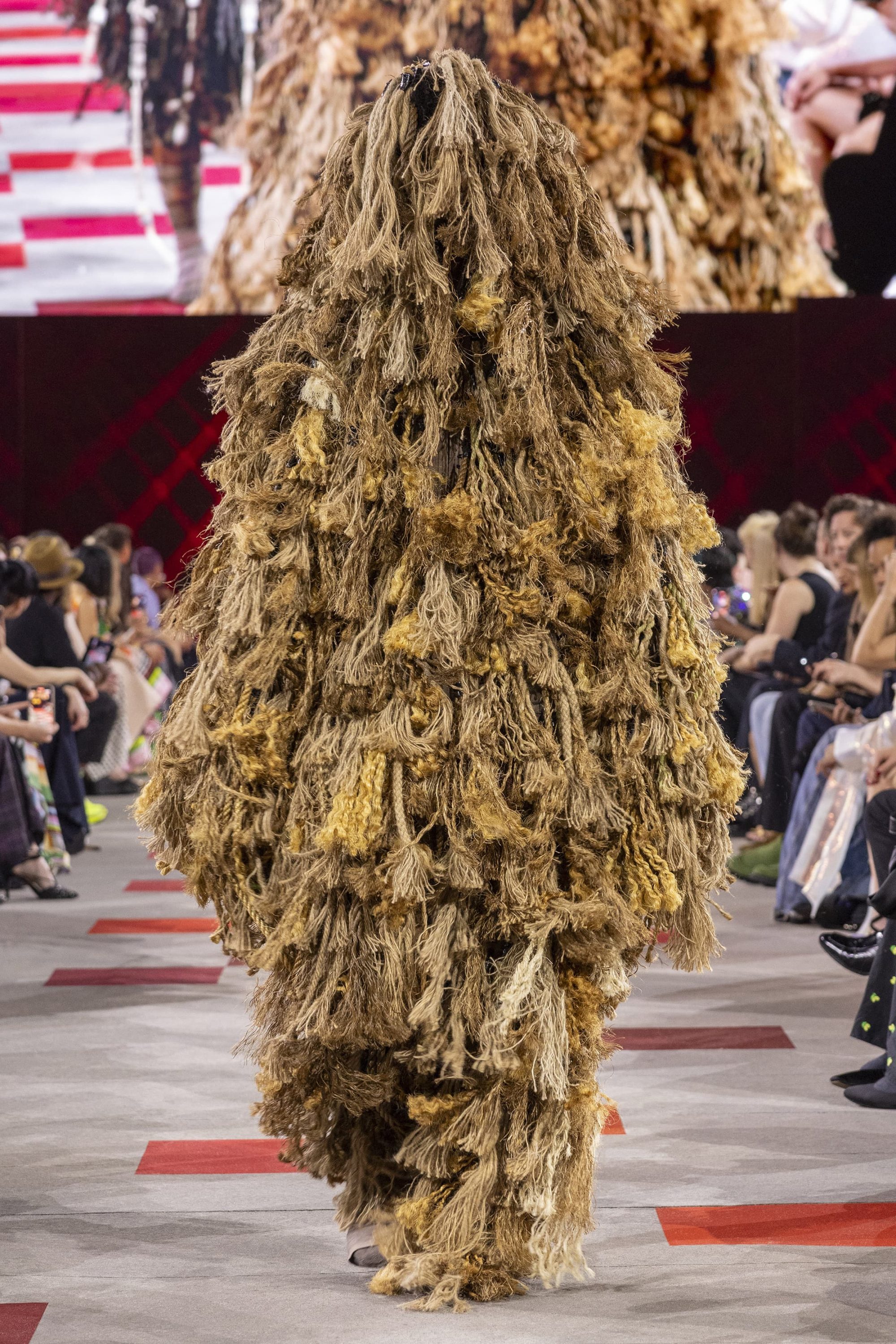
Xiaotong Wang
What was the primary inspiration behind your latest collection, and how did you translate this inspiration into your designs?
Throughout history and in particular from the 19th century, men’s clothing and fashion have been governed by strict rules and codes of conduct which have changed very little. In general, most menswear in contemporary fashion is still very conservative and adheres to these “traditional codes”, such as shirts, jackets, or pants.
I wanted to move the needle forward for contemporary men’s fashion with my collection by ‘liberating’ the psychology of the menswear consumer to change both the garments and the perception of how clothing should be worn. Specifically to change the concept of traditional constraints i.e., color, where to wear certain “looks”, and the use of fabrications. This reflection is especially relevant at this moment when there is a continuous reflection on gender and gender-related clothing – and how the menswear consumer, and the industry, are upending the role of masculinity in traditional menswear.
This collection aims to explore the development and differences and the role of men’s clothing within Chinese and Western cultures and create a balance between these cultural identities. Also, to express these cultural elements through different clothing silhouettes and normalize non-traditional menswear through deconstruction techniques, asymmetrical design, and superposition of layering. In addition, it explores the Western idea of modernity, the difference in the way images are portrayed in men’s fashion, and tries to find a balance between these aspects.
Can you describe the core elements of your brand DNA? What unique aspects define your design aesthetic and differentiate your brand from others?
Influenced by the concept of deconstructionism, the XIAOTONG WANG fashion brand pursues the aesthetics of “asymmetry” and “non-traditional”. I am committed to exploring the cultural differences between Eastern and Western fashion design and finding the balance between these differences, integrating Eastern and Western culture into fashion design. My design style combines large outlines, simple lines and delicate layers. “Clothing is not just a covering for the body, it is also an expression of individuality” is my brand DNA.
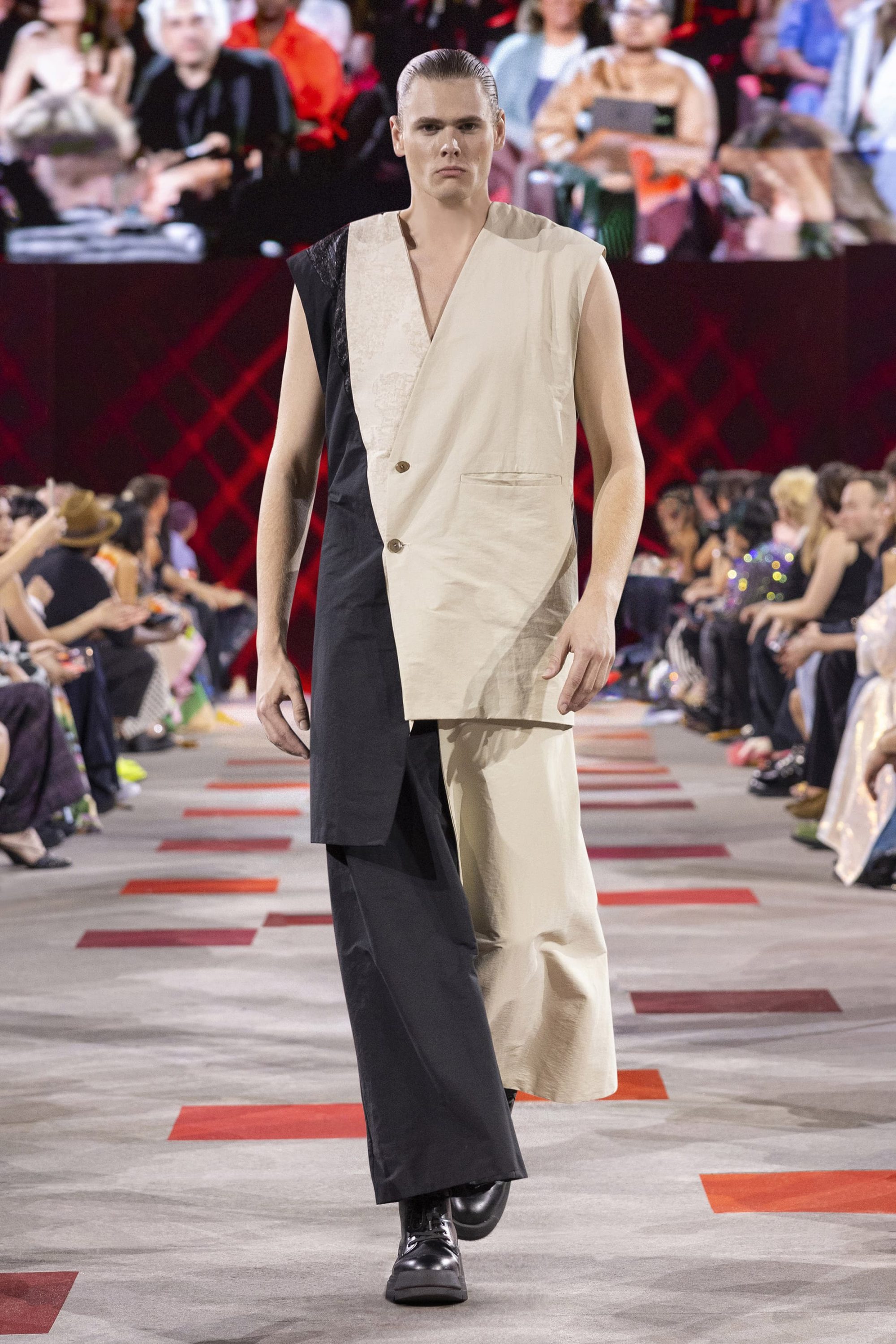
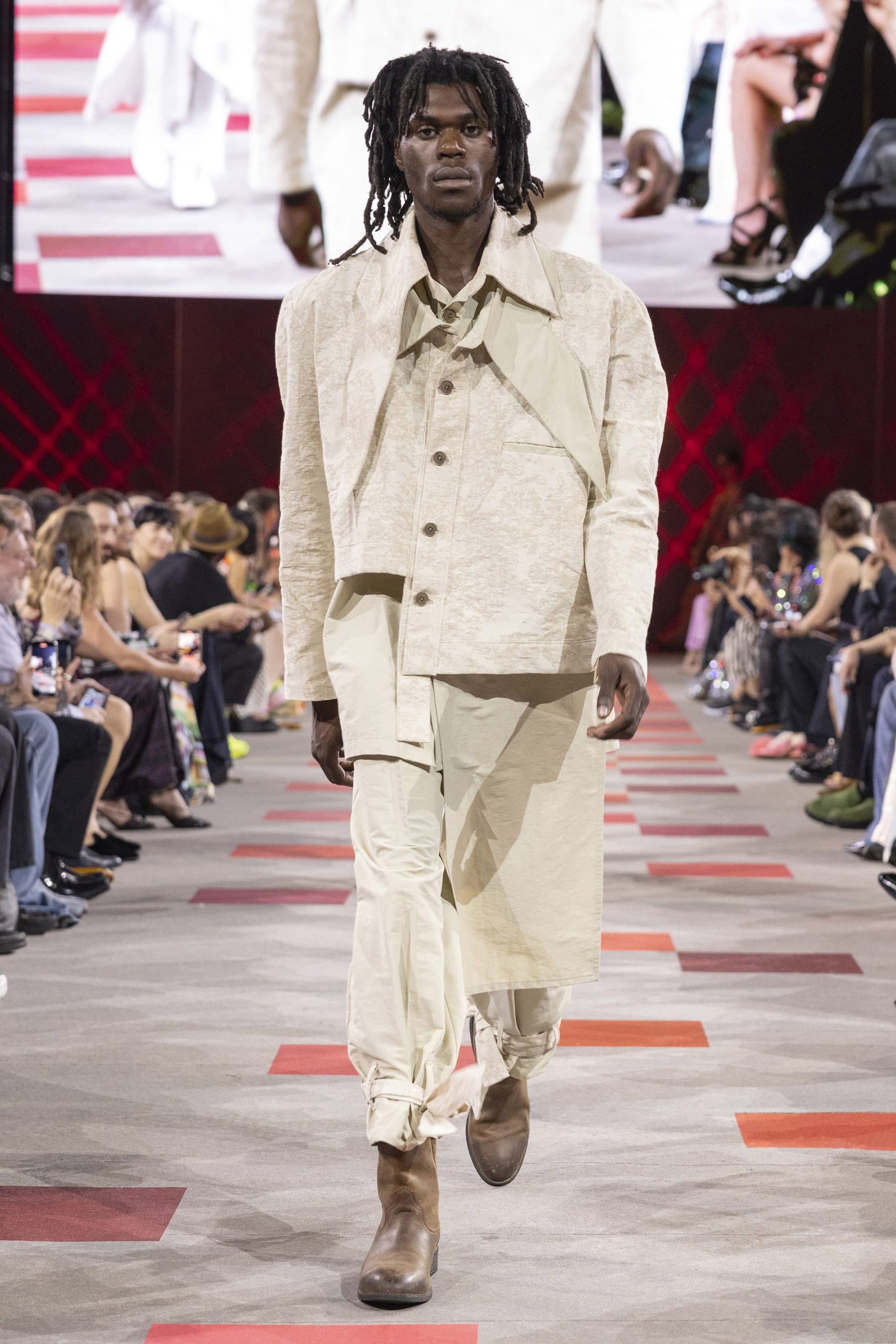
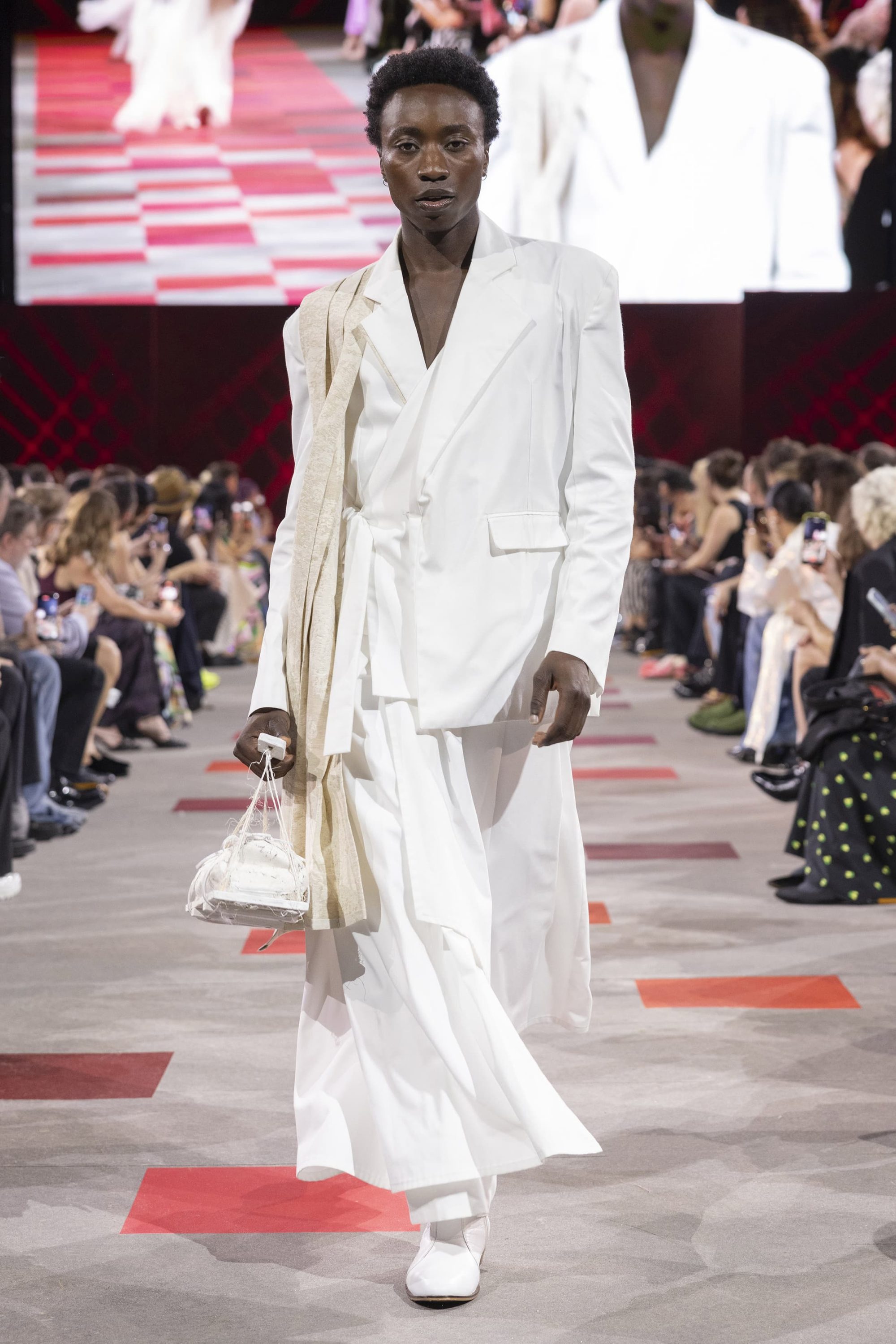
Isabelle Ferrugia
What was the primary inspiration behind your latest collection, and how did you translate this inspiration into your designs?
“Peak of Perfection” initially began with revisiting my time as a competitive dancer, spending 15 years of my life completing intense training. Throughout this time I developed deconstructive perfectionist habitats and focused my collection on the idea of perfectionism as a whole. This is translated through the use of repetition which is an element I focused heavily on. From the repeating top stitching details to the pleated silk organza to the laddered fine gauge knitting, every detail is thought through and correlates back to the initial inspiration.
Can you describe the core elements of your brand DNA? What unique aspects define your design aesthetic and differentiate your brand from others?
The core elements of my brand DNA are focusing on the details- incorporating design elements in unique and innovative ways. Finding new ways to finish garments, like binding fine gauge knit with raw-edged silk organza and seamlessly combing knits and wovens into my designs. Focusing heavily on textile manipulations and how to elevate fabric like the top stitching detail seen throughout my collection.
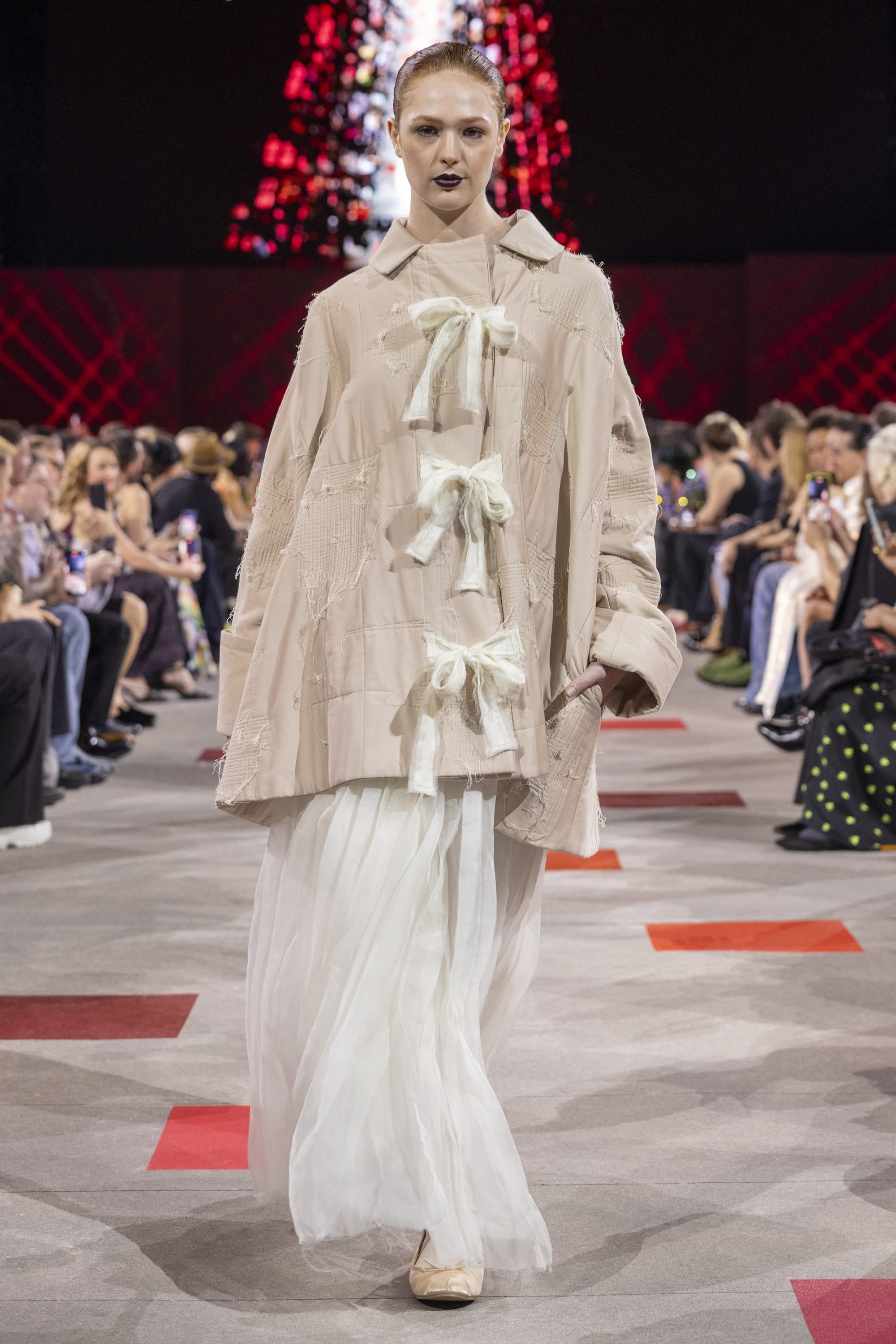
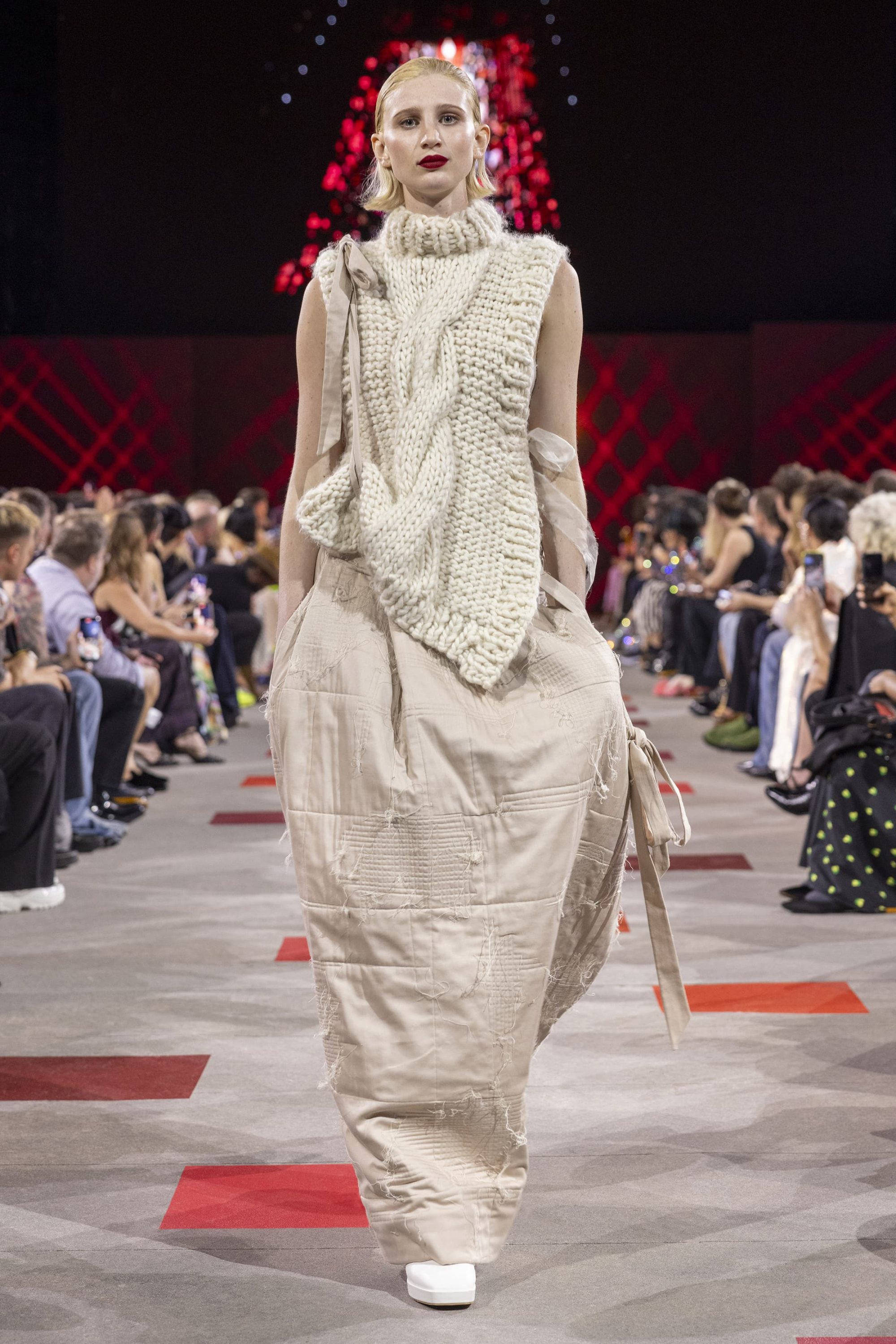
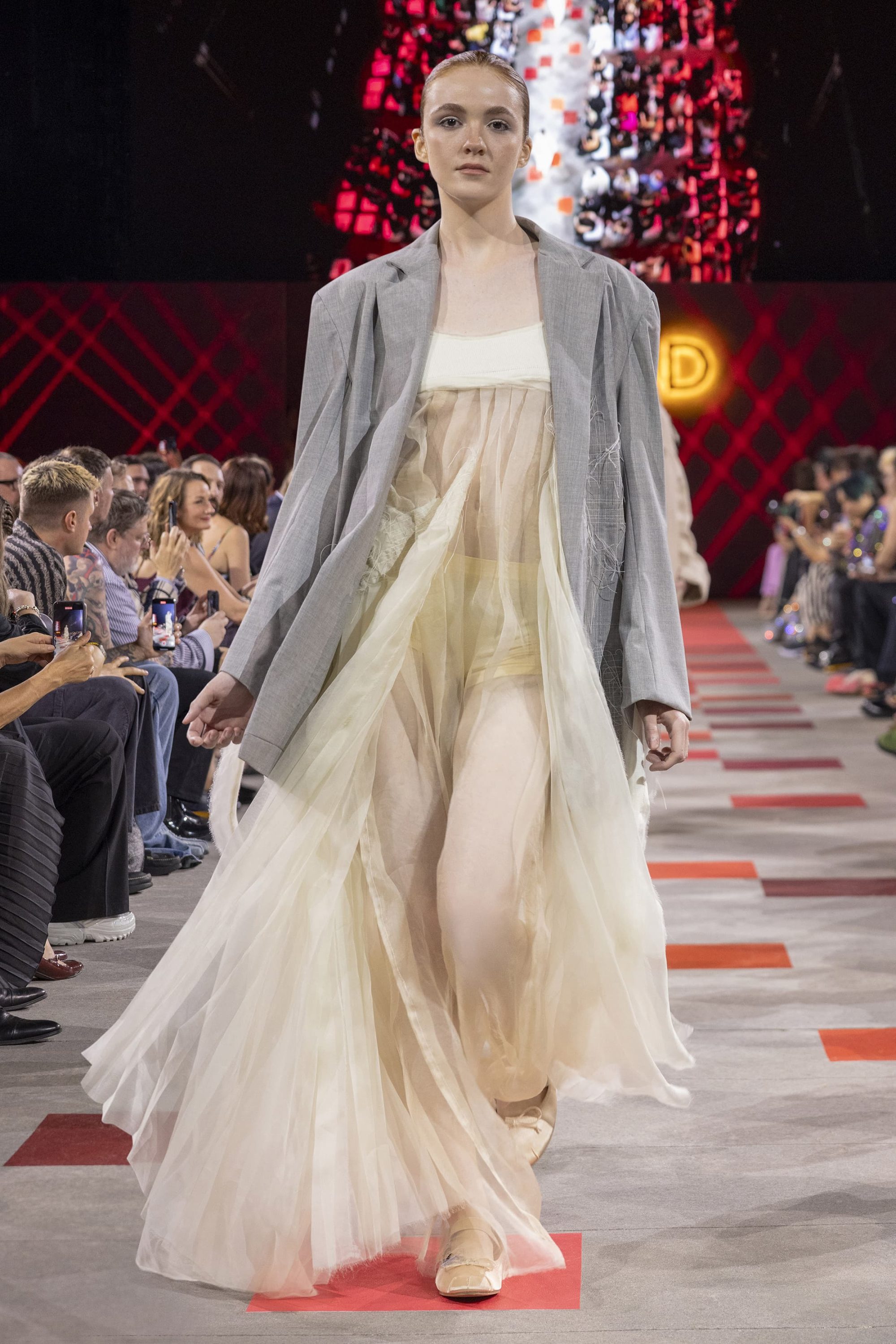
Marky Bergeron
What was the primary inspiration behind your latest collection, and how did you translate this inspiration into your designs?
My collection, “Opus One,” draws inspiration from a fusion of urban streetwear influences and the luxurious detailing seen in designs from esteemed fashion houses like Amiri, Balmain, and Dolce & Gabbana. I aimed to capture the essence of modern urban living infused with elements of opulence and extravagance. This vision was then translated into the collection through my use of heavily embellished crystals and intricate tapestries, which adorn my garments with a sense of grandeur and artistic flair. I wanted each piece to reflect a harmonious balance between high fashion aesthetics and practical streetwear sensibilities, offering wearers a unique blend of luxury and urban chic.
Can you describe the core elements of your brand DNA? What unique aspects define your design aesthetic and differentiate your brand from others?
At the core of my brand, Sibilance’s DNA lies a commitment to blending urban sophistication with opulent detailing. My designs are characterized by bold expression, featuring daring silhouettes, vibrant colors, and innovative fabric combinations that push the boundaries of conventional fashion. What sets us apart is our fearless approach to creativity, coupled with meticulous craftsmanship that ensures each piece maintains impeccable quality and wearability. Additionally, cultural diversity serves as a key source of inspiration, infusing a global perspective that resonates with a diverse audience. This cultural fusion offers a fresh perspective on contemporary luxury fashion. Ultimately, I want Sibilance to stand out by seamlessly blending opulence with urban edge, daring design with meticulous craftsmanship, and cultural fusion with contemporary relevance, thus creating a distinctive brand identity that appeals to fashion-forward individuals seeking both luxury and wearability.
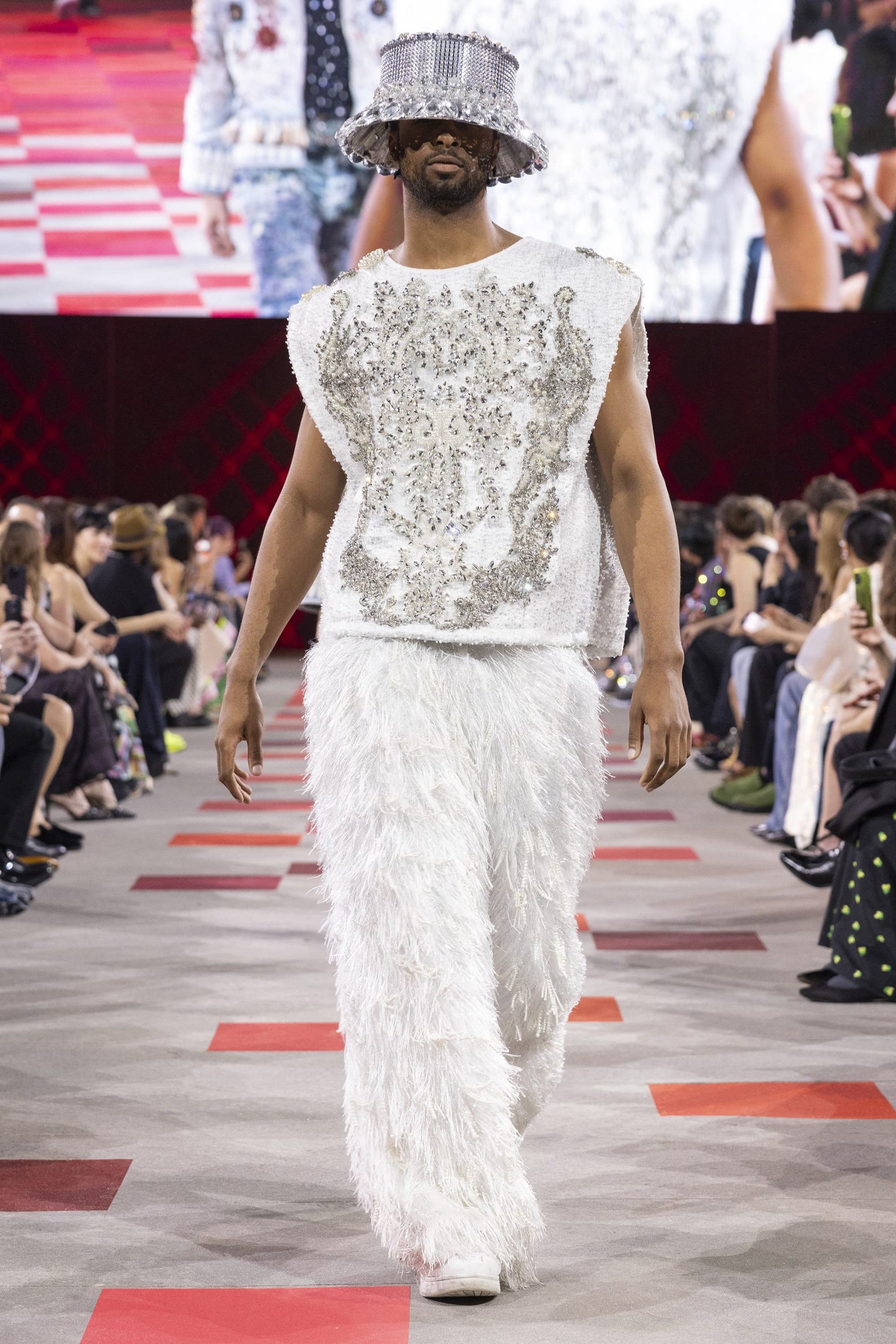
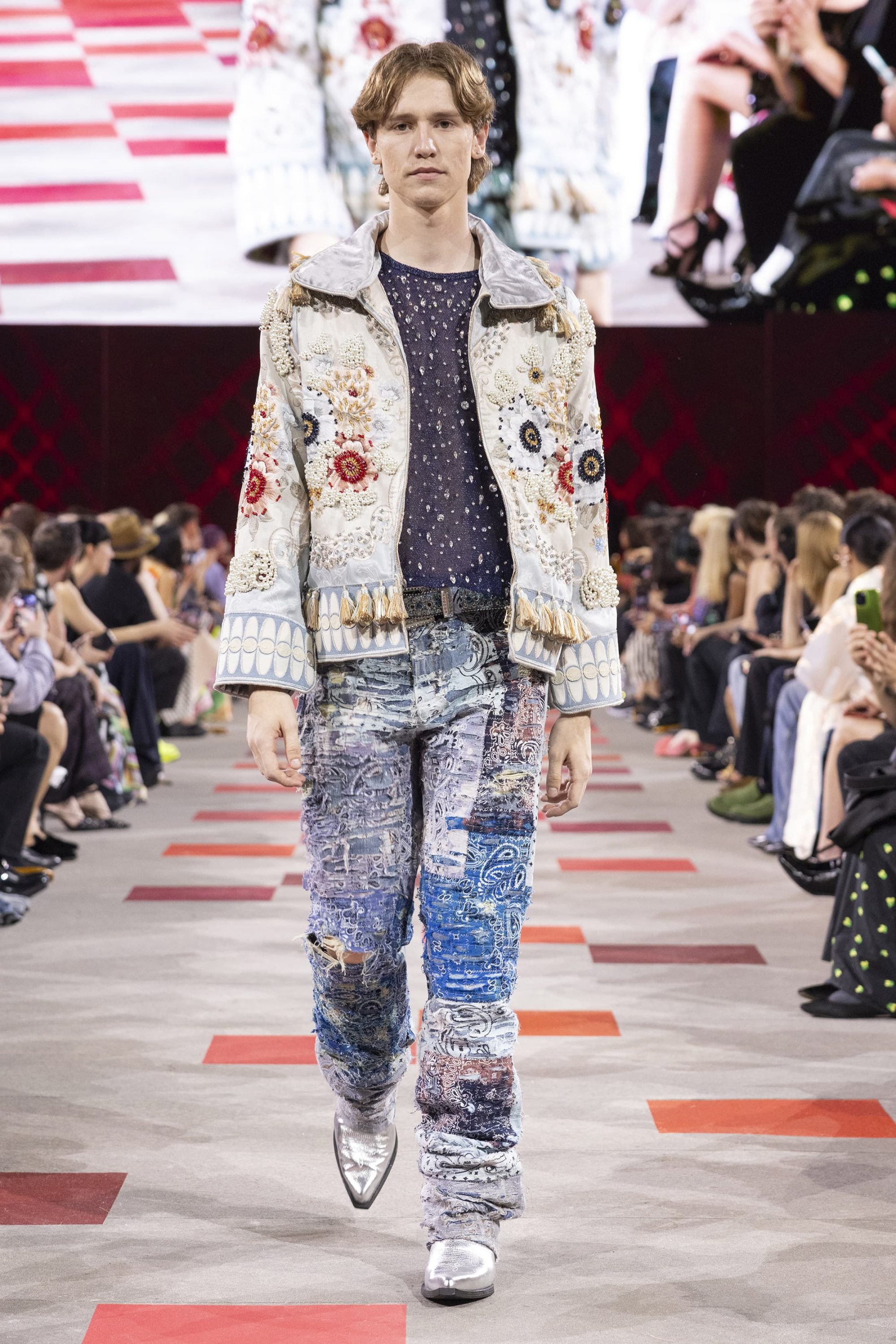
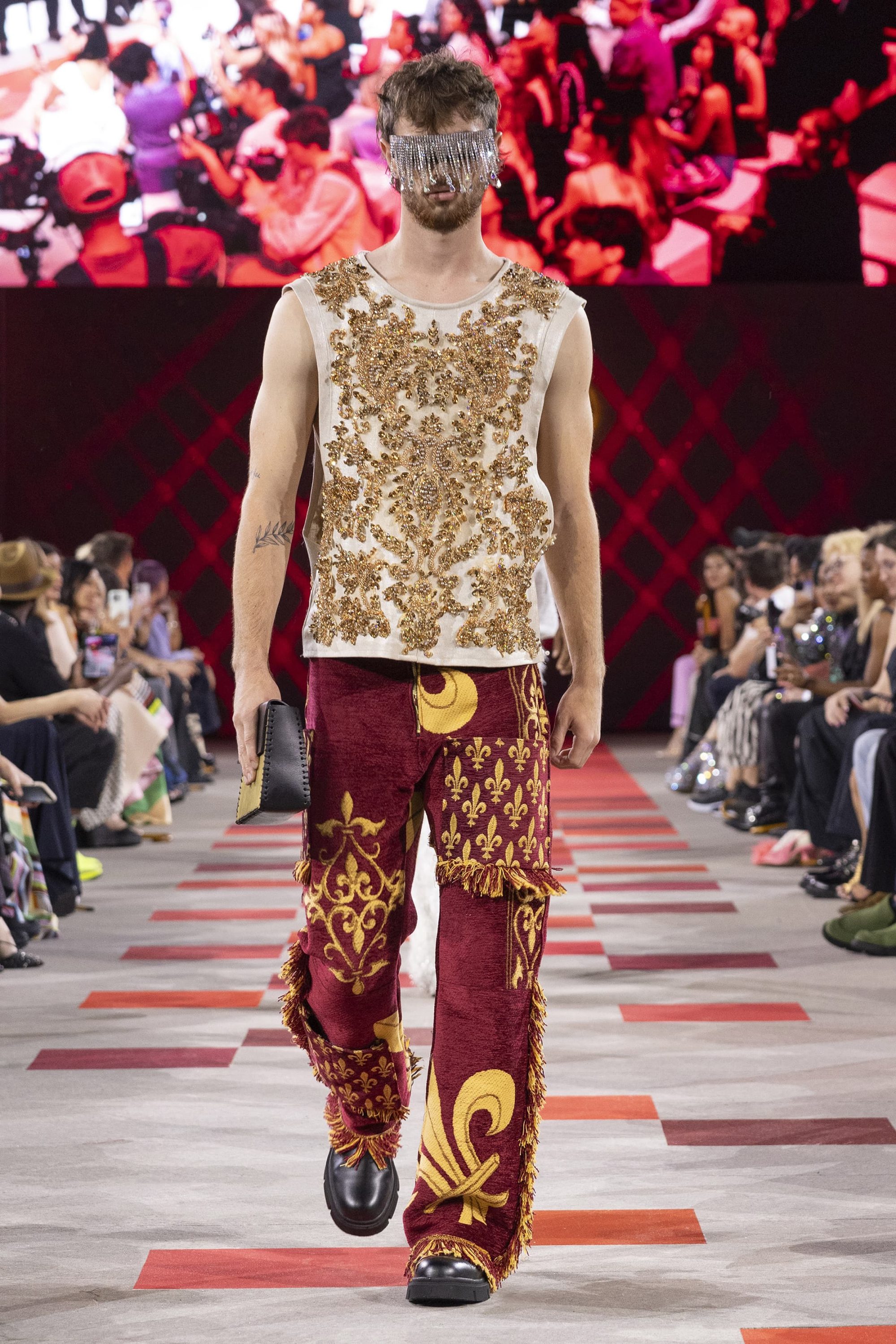
Lauren Mika
What was the primary inspiration behind your latest collection, and how did you translate this inspiration into your designs?
My research started by looking at animals in hibernation. This led me to wonder what it would look like if humans hibernated too. I often find myself at a place needing to rest and reset, just wanting a break from reality and time away to hibernate. My senior collection Please Tuck Me In is a place where emotions of nostalgia and looking through a dreamscape lens come to life. Soft pastel colors with cozy beading like prints were designed to help feel like the wearer is wrapped up in bedding. Within this idea of hibernation there are feelings of protection and safety. The balance of sheer textiles with puffy elements allow the wearer the ability to be seen yet protected and distanced from others. Please Tuck Me In was sponsored by Swarovski crystal. Crystal elements created a lulling effect by fading out or scattered like dew drops over the garments.
Can you describe the core elements of your brand DNA? What unique aspects define your design aesthetic and differentiate your brand from others?
I have always been drawn to things that bring joy and happiness. For me dressing and designing garments that have color and prints have allowed me to feel those emotions. One thing I try to keep in mind when designing is to not take fashion so seriously, to simply design and be free with it. Overall, I’ve always appreciated the aspect of fashion which allows me to do what I love and hopefully bring that childlike joy to others too through clothing.
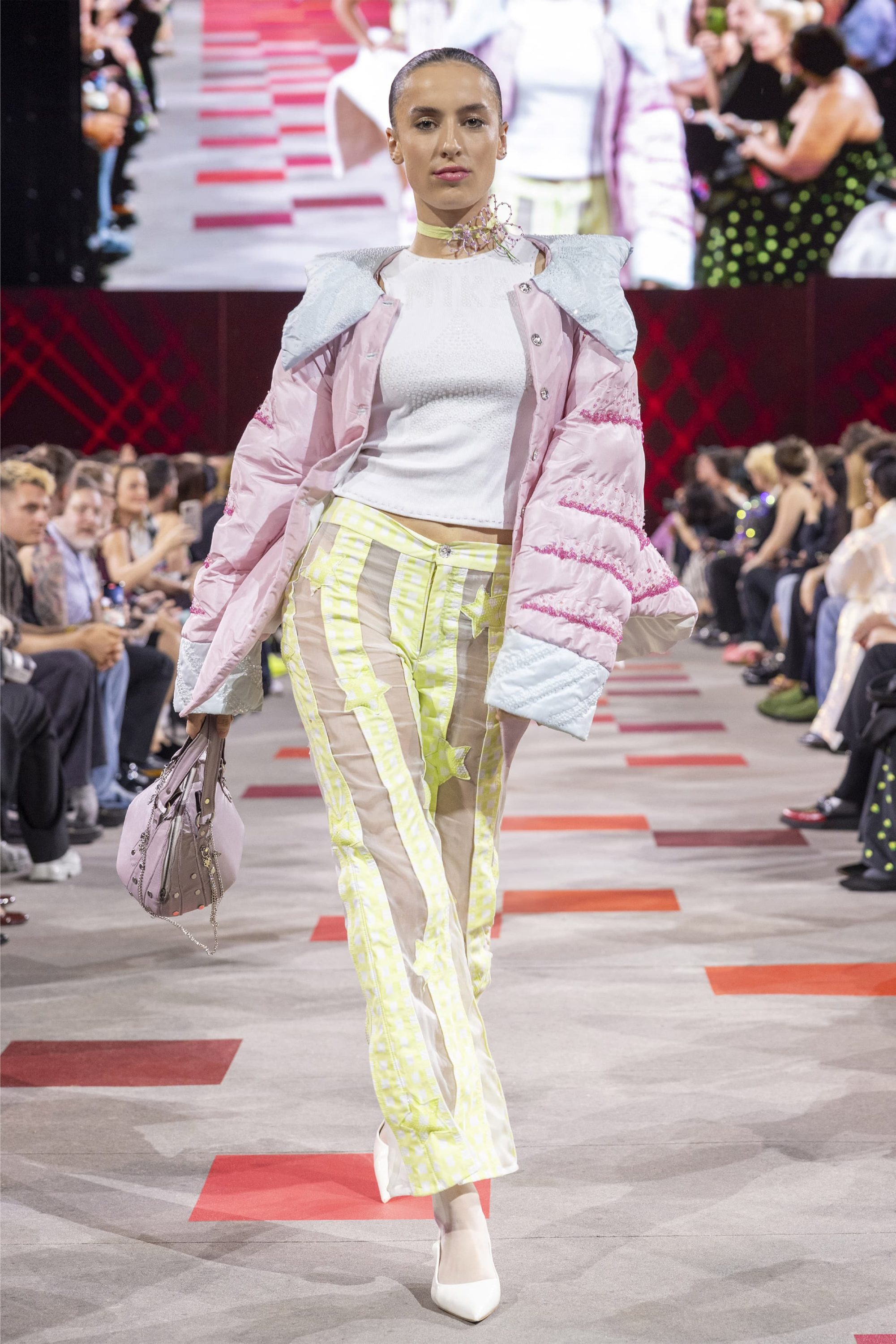
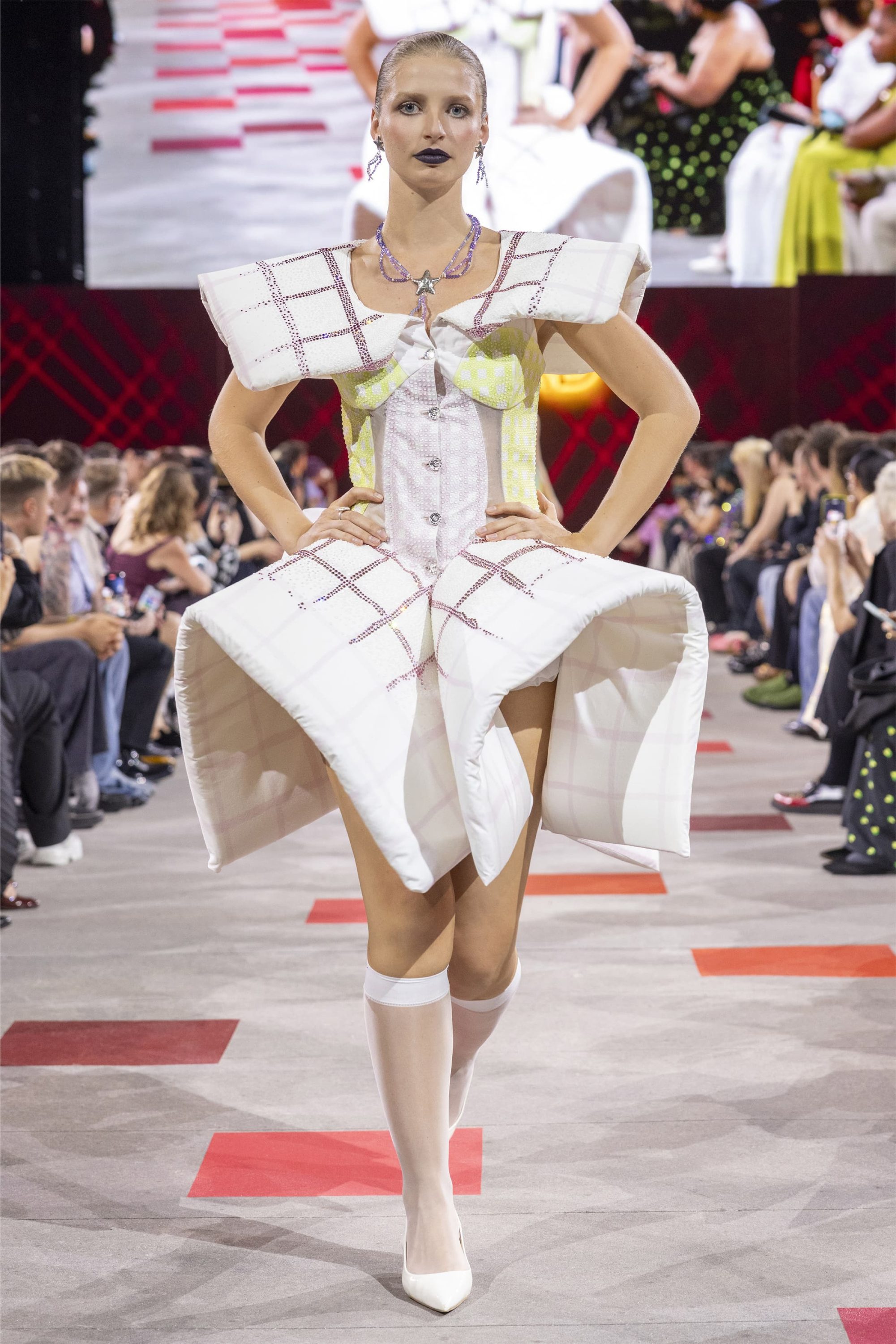
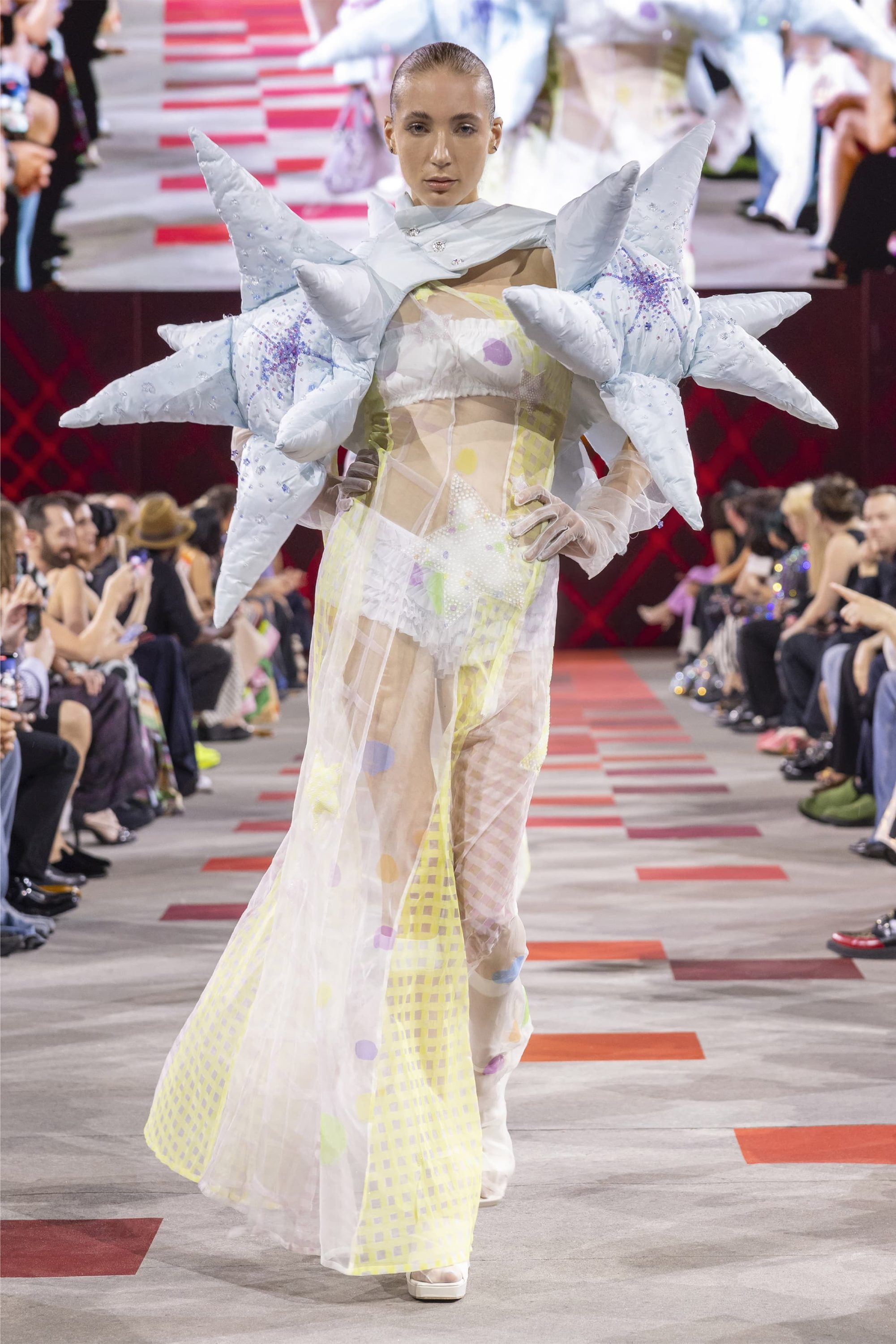
(Phoebe) Wei Chun Sun
What was the primary inspiration behind your latest collection, and how did you translate this inspiration into your designs?
My collection Fruits of Love attempts to capture the essence of romantic love. Inspired by my summers in Guangdong, China, which is very well known for its high-quality lychee, which is seen as a gift of affection. Seeing all the lychee being passed around got me thinking about the reason behind Asian fruit gifting culture. I realized it’s not just a way to show respect or to build “guanxi,” a connection between bosses and coworkers, family and friends, but also a way to give and receive ‘love’. My exploration led me to question what love means to me. I realized that the only type of love I could not fully comprehend was romantic love, which I’ve never experienced. In my mind, the closest comparison to its flavor and feel would be fruits. 3 core ideas translate my research into final designs:
1. Love is about building a connection between people, and Chinese fruit gifting culture
maintains this link. This interaction between people is essential. Therefore, all my designs feature ways of connecting and linking to each other. I also utilized thermochromic fabric, which changes color with body heat, encouraging physical touch and showing love’s ripening.
2. Love and people are like fruits; each requires a different care method to grow, and people are fragile, and come in a variety of diverse flavors. Like fruits, relationships ripen over time and will eventually rot away. Still, as life is an everlasting cycle with fruit seeds bearing new trees, the idea of love changes form through time but will never truly end. Therefore, love is a round sphere. I reflected on this by creating wet-felted wool elements in my work to emulate the fuzzy texture of moldy fruits. This ranges from fully felted shirts and skirts to round 3D pods for connection.
3. Ancient Chinese sayings and auspicious beliefs link fruits to love. I selected 5 key fruits as the basis for the silhouettes of the 5 looks in my collection. Mandarins for SUCCESS and WEALTH, pomelos for ABUNDANCE and UNITY, pomegranates for INFATUATION and BRAVERY, apples for SECURITY and PROTECTION, and peaches for YOUTH and IMMORTALITY of love.
Can you describe the core elements of your brand DNA? What unique aspects define your design aesthetic and differentiate your brand from others?
As a designer and artist, I see my designs as ‘spontaneous and simple little treasures’. It’s about capturing an unseen fragment and formulating it into stories. I don’t think collections must always stem from a deeper philosophical meaning of addressing a big issue. There are many exciting things in everyday life from which I can draw inspiration, and these things are alive and vital to me. These ‘fragments’ can range from a variety of everyday things and thoughts, such as the smell of a street market and temple and why it makes me want to cry, the annoyed huff of my 8-year-old pug, the ache you get in your gums when you eat something sweet, or in the case of my senior collection in understand what exactly ‘love’ is to me. If I had to pinpoint something that differentiates my brand/designs from others, I would probably say it’s the ability to capture a relatable yet unusual moment in time and the use of wool felting as a craft. Discovering wool-felting is my ‘spontaneous and simple little treasure .’ Felting is straightforward yet complex; you basically rub and roll wet, soapy wool fibers together, causing them to contract to end up with something solid enough to hold, but there’s actually a lot of experimentation and calculations that goes behind it. The element of imperfection and not fully knowing how the final product will turn out excites me. Using my hands repeatedly to work the felt for hours feels like a physical way to translate the idea of turning simple ‘fragments’ into definable stories.
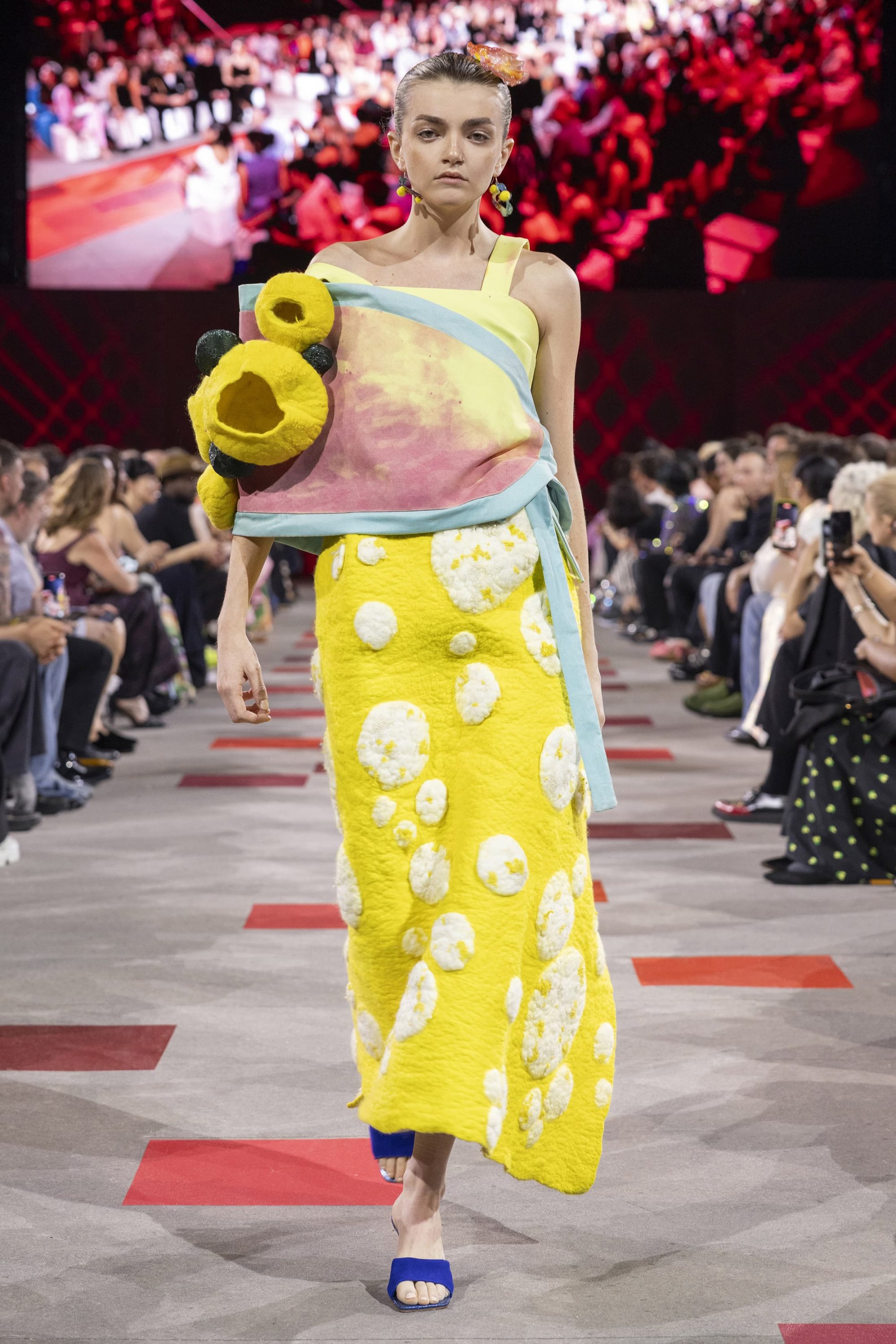
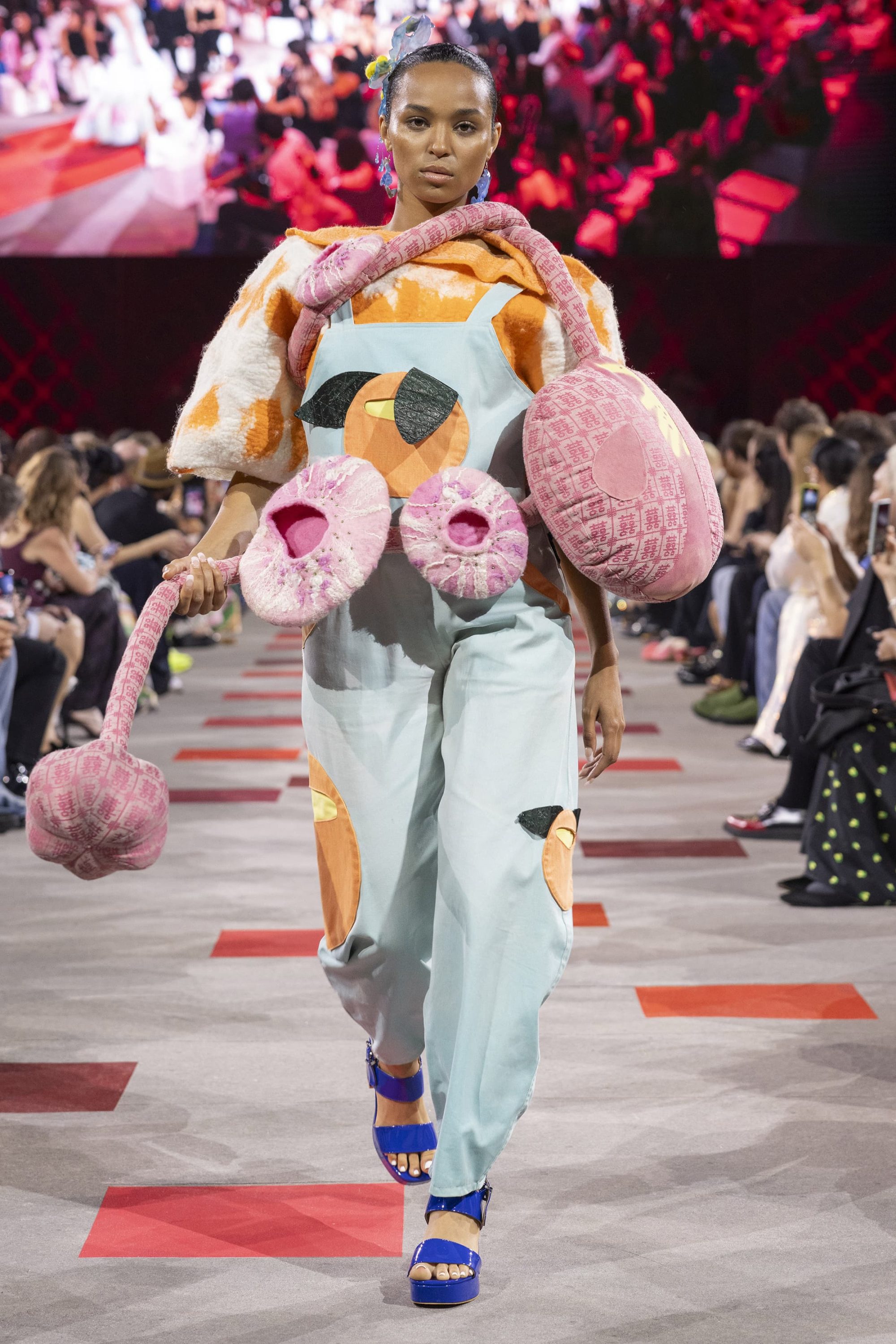
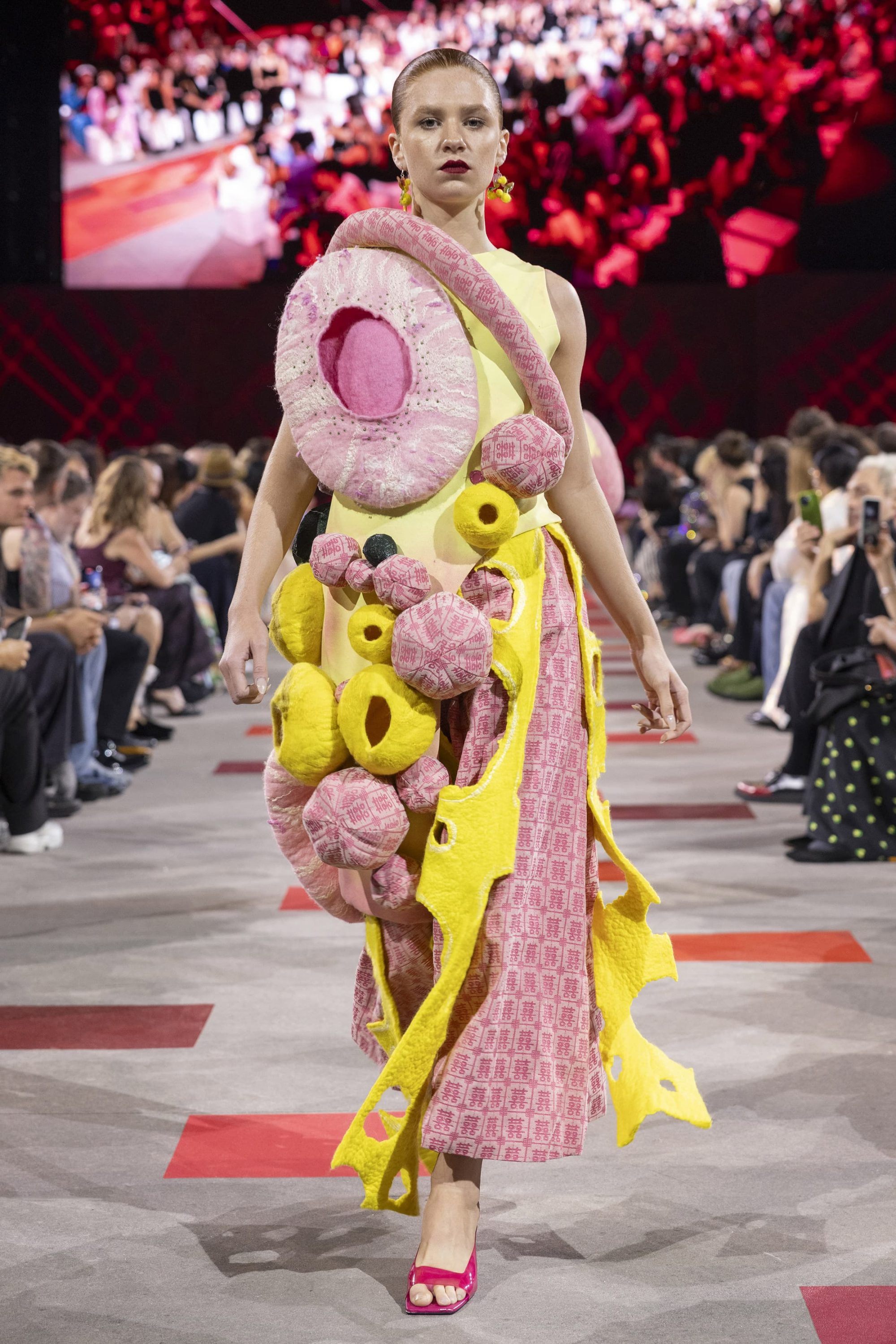
Chuck Ryan
What was the primary inspiration behind your latest collection, and how did you translate this inspiration into your designs?
The primary inspiration behind my latest collection, “Mind Maze,” was challenging the traditional societal norms and supporting following personal dreams instead of just fitting in. Living with severe dyslexia taught me to see the world through pictures and symbols, turning a challenge into a unique perspective. I translated this inspiration into my designs by taking the 9-to-5 men’s tailored traditional look that the system pushes you towards and redefining it for someone who wants to pave their own path and chase their dreams. Inspired by elements like lined notebook paper and graph paper, “Mind Maze” highlights the limitations of traditional systems and celebrates the importance of embracing uniqueness and pursuing personal aspirations. Ultimately, this collection aims to ignite a sense of empowerment, urging everyone to recognize their potential and chase their dreams.
Can you describe the core elements of your brand DNA? What unique aspects define your design aesthetic and differentiate your brand from others?
The core elements of my brand DNA are rooted in defying norms and carving out your own path. Drawing inspiration from my sports background and navigating dyslexia, I bring a unique perspective to my designs by mixing unexpected textiles and breaking traditional rules. My journey has shown me that unconventional paths can lead to the most impactful creations. By encouraging others to embrace their individuality and fearlessly pursue their dreams, I aim to inspire a new generation of boundary-breakers in the fashion world and beyond.
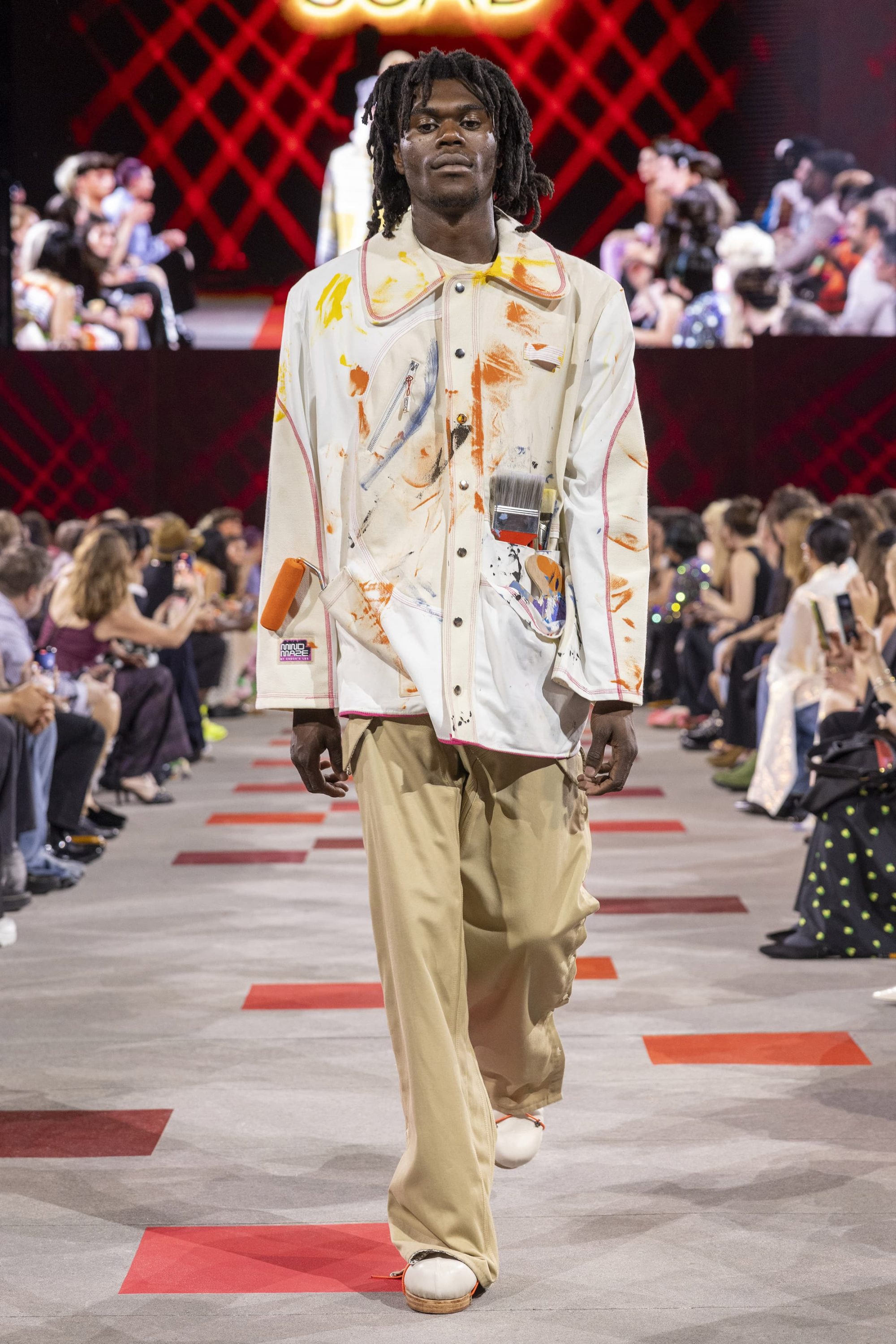
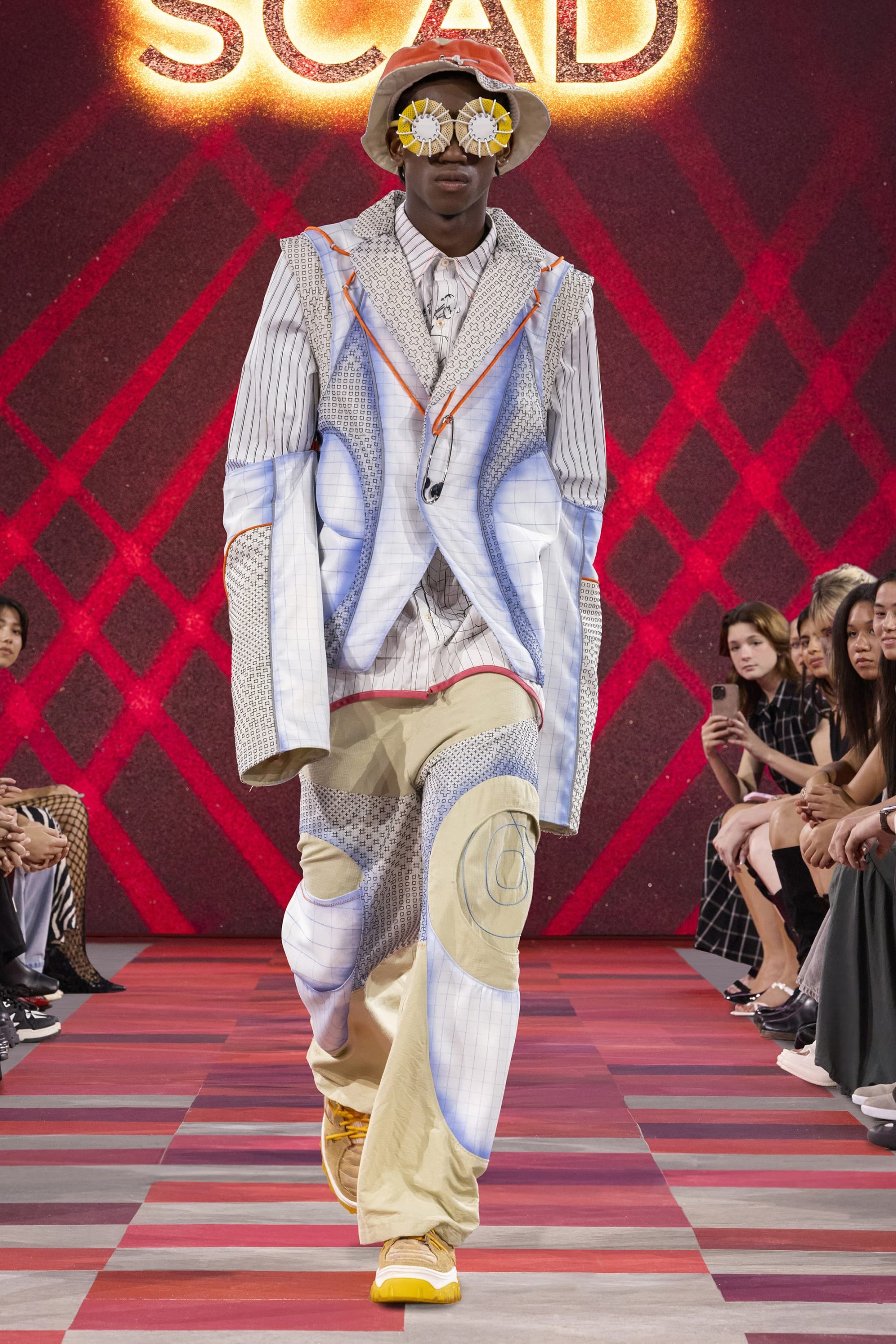
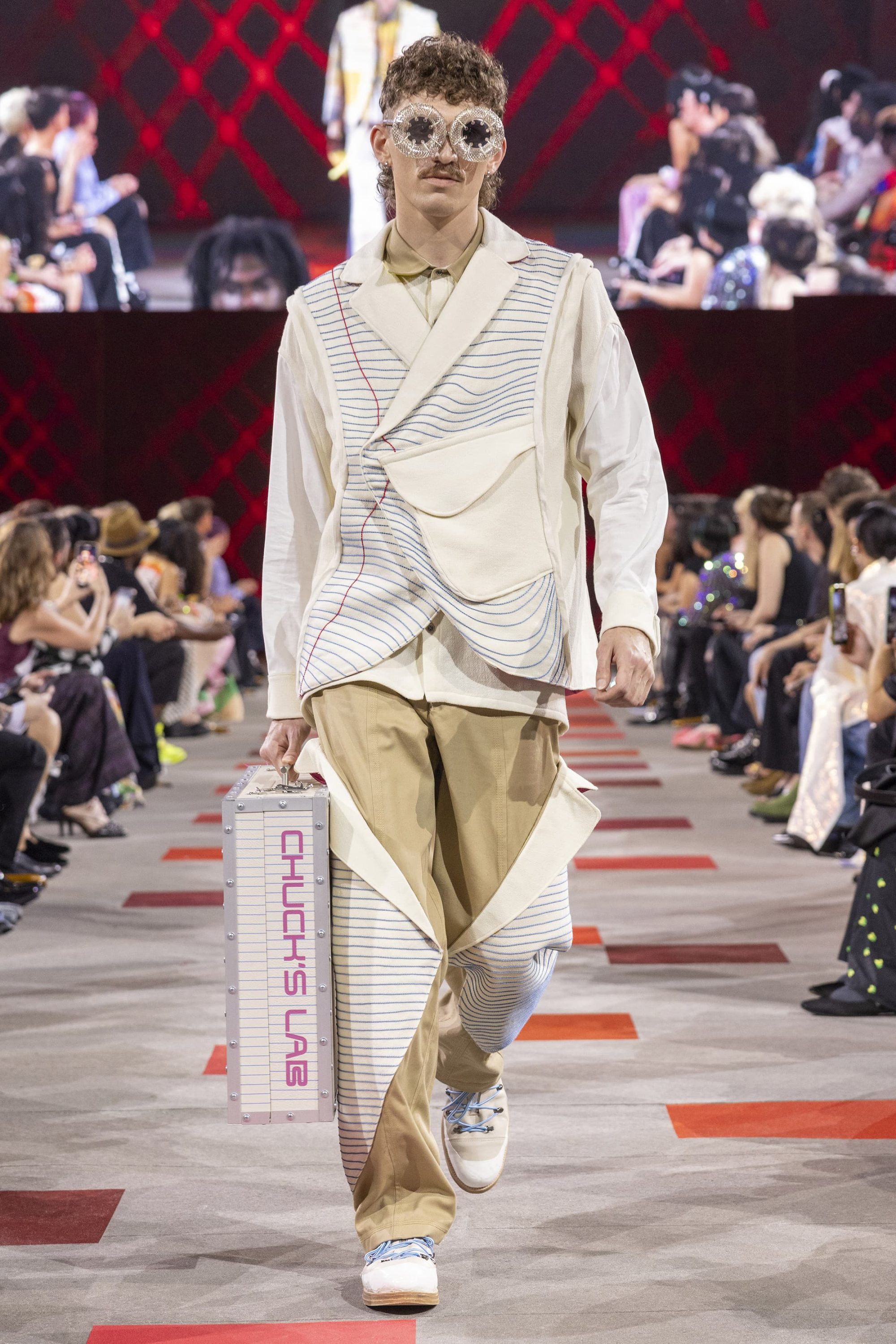
Maggie Foster
What was the primary inspiration behind your latest collection, and how did you translate this inspiration into your designs?
In this collection, I want to bring out the nostalgic charm of Mad Magazine comics and mix it with influences from standard streetwear and menswear silhouettes. I used vibrant colors and distinctive graphics to create a blend that honors the classic humor while adding a modern, stylish twist. This menswear collection is for everyone looking for high-quality, unique pieces that add fun and playfulness to everyday life. My goal is to make clothes that serve as an outlet for wearers to inject joy into every part of their daily experiences.
Can you describe the core elements of your brand DNA? What unique aspects define your design aesthetic and differentiate your brand from others?
When I design, I gravitate towards menswear and feel that is where my ideas come out the strongest. I like to pay homage to the standard and sleek menswear silhouettes of the past 50-70 years looking at what men wore based off of the social and political crises of the time and connecting that into my work. I then add new and interesting textures with my knitwear and unusual fabrics. I feel that all of these factors together are the start of a new perspective on menswear and ready-to-wear clothing all together.
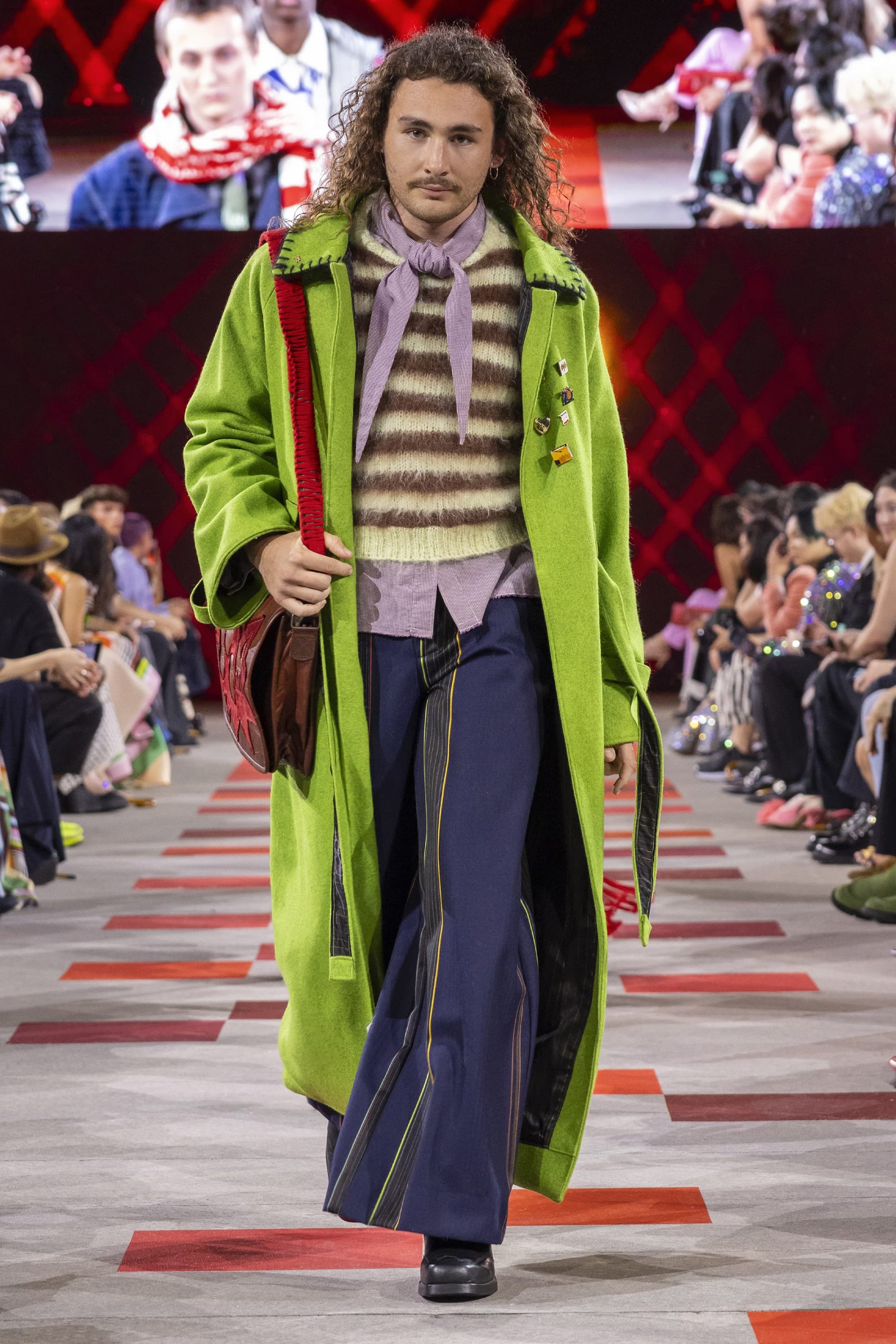
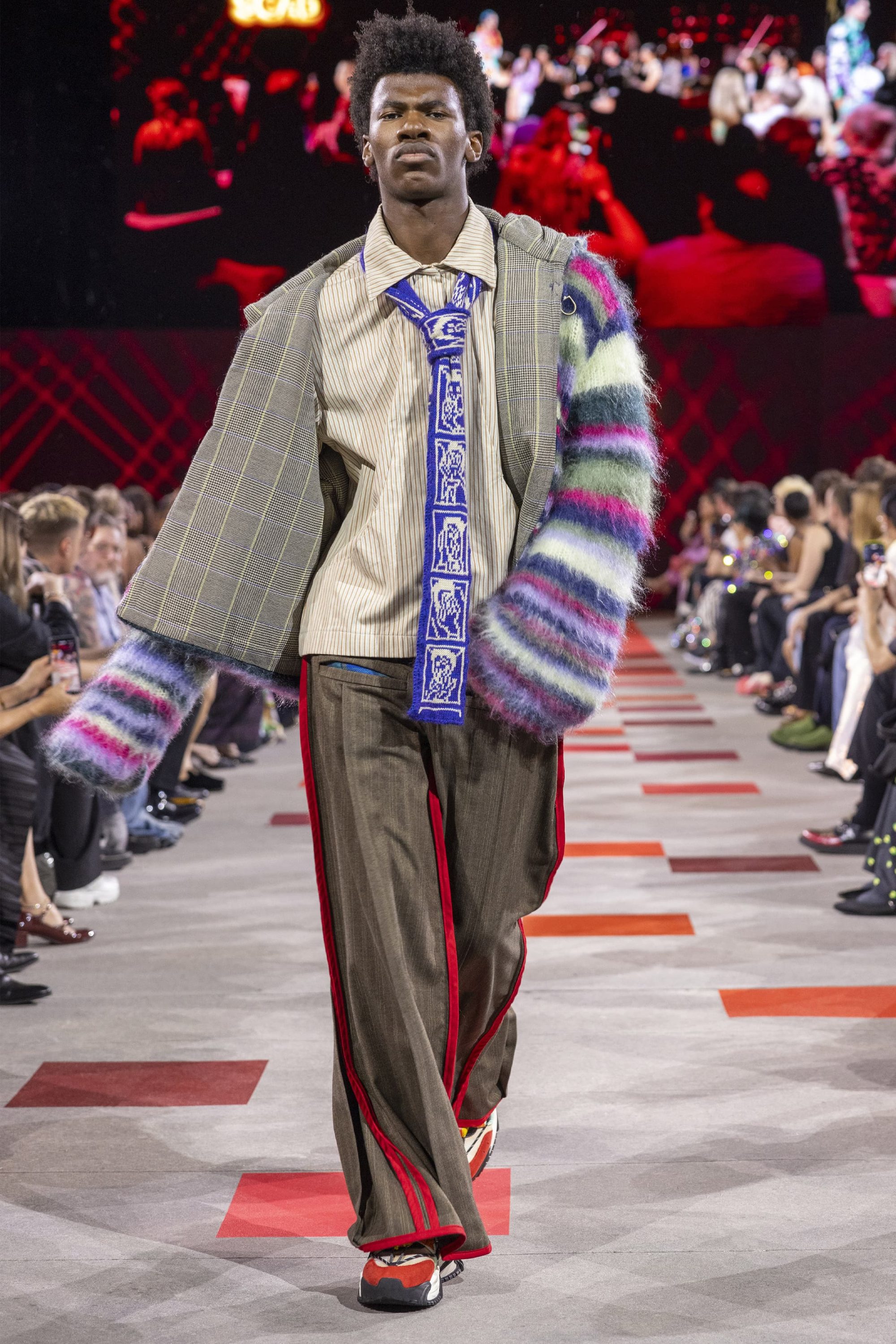
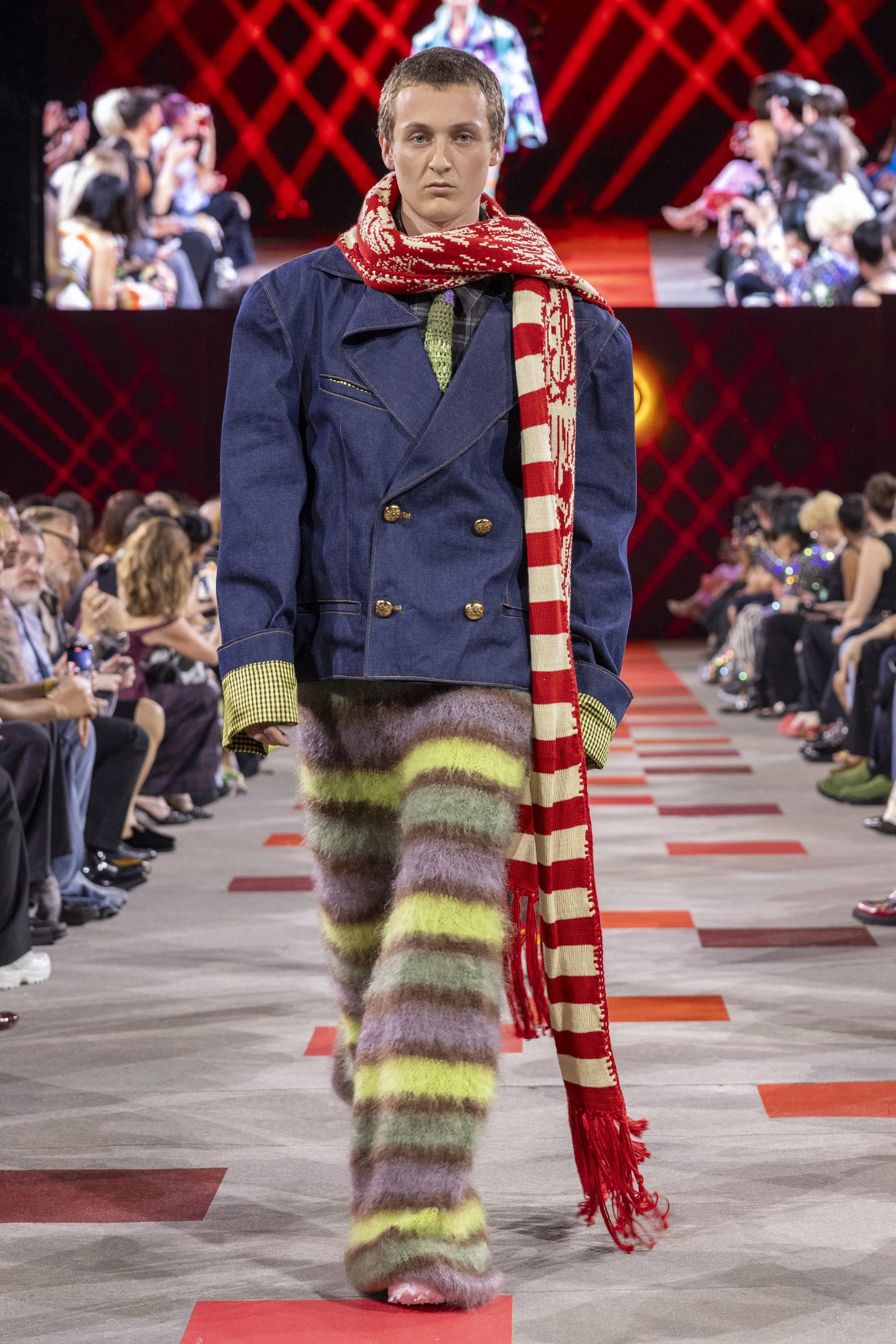
Richenelle Isip
What was the primary inspiration behind your latest collection, and how did you translate this inspiration into your designs?
“Children of the Diaspora” celebrates the juxtaposition of two different worlds: the Philippines and the States. Growing up in the states as Filipino-American, it was difficult to feel entirely one or the other, Filipino or American. My collection encapsulates my journey of identity and acceptance through focusing on traditional Filipino garments like the terno sleeve, barong, traditional lace paired with Western tailoring through the use of wool and bespoke detailing. Moreso, lace is utilized in a way to elevate and uplift the message of the similarities of both worlds: calling on the intricate embroideries of sheer traditional garments and evoking the luxuries of the western world; it is a bridge between the cultures I grew up in. In adapting traditional patterns, and taking traditional womenswear into menswear, I hope to say that even though I was not raised in the mainland nor had the same experiences or understanding of my culture, it does not make me any less Filipino nor any less American.
Can you describe the core elements of your brand DNA? What unique aspects define your design aesthetic and differentiate your brand from others?
The core of all my designs is my journey with my identity and culture; in other words, my designs are intimate. I focus a lot of my designs on structure and construction, especially with the design and adaptation of the terno sleeve. Similarly, I care about how my garments are perceived and the messages that I can convey, such as creating androgynous designs through the juxtaposition of various material’s connotations like lace and wool. In turn, my interpretations of Filipino and western details express the pride I hold for both cultures despite not being the “perfect Filipina”. Every detail is informed by my personal life and the “in between” I felt growing up.
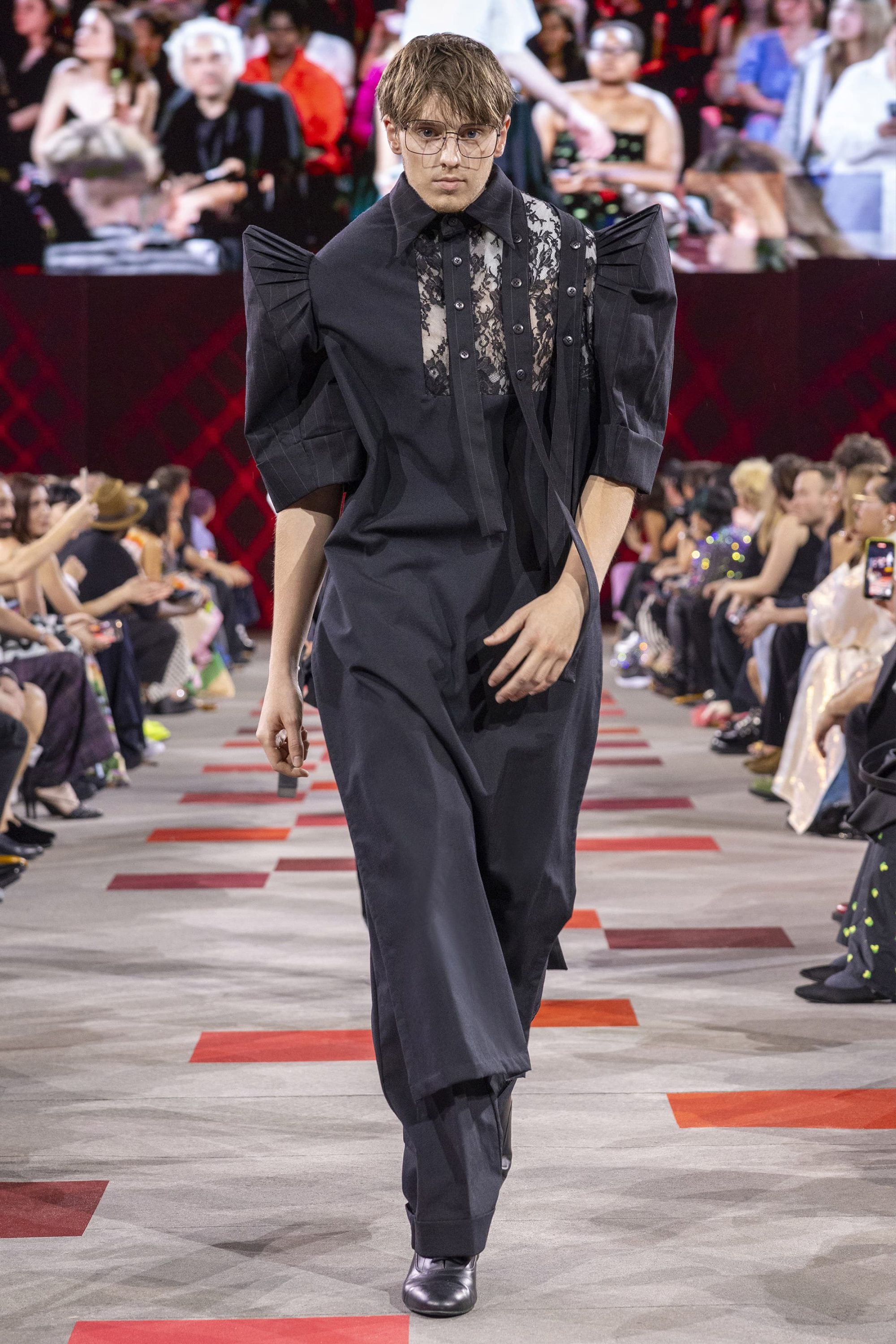
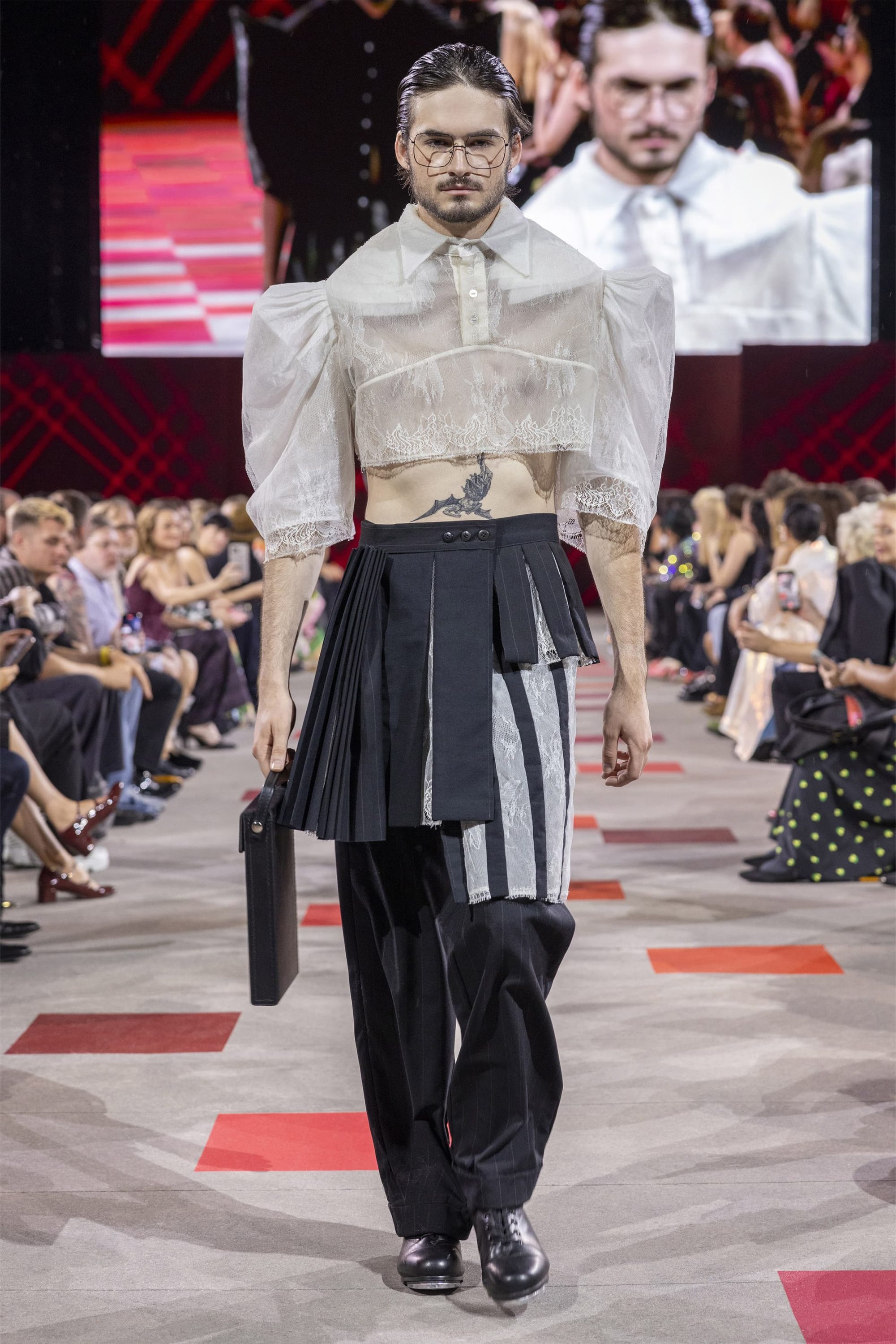
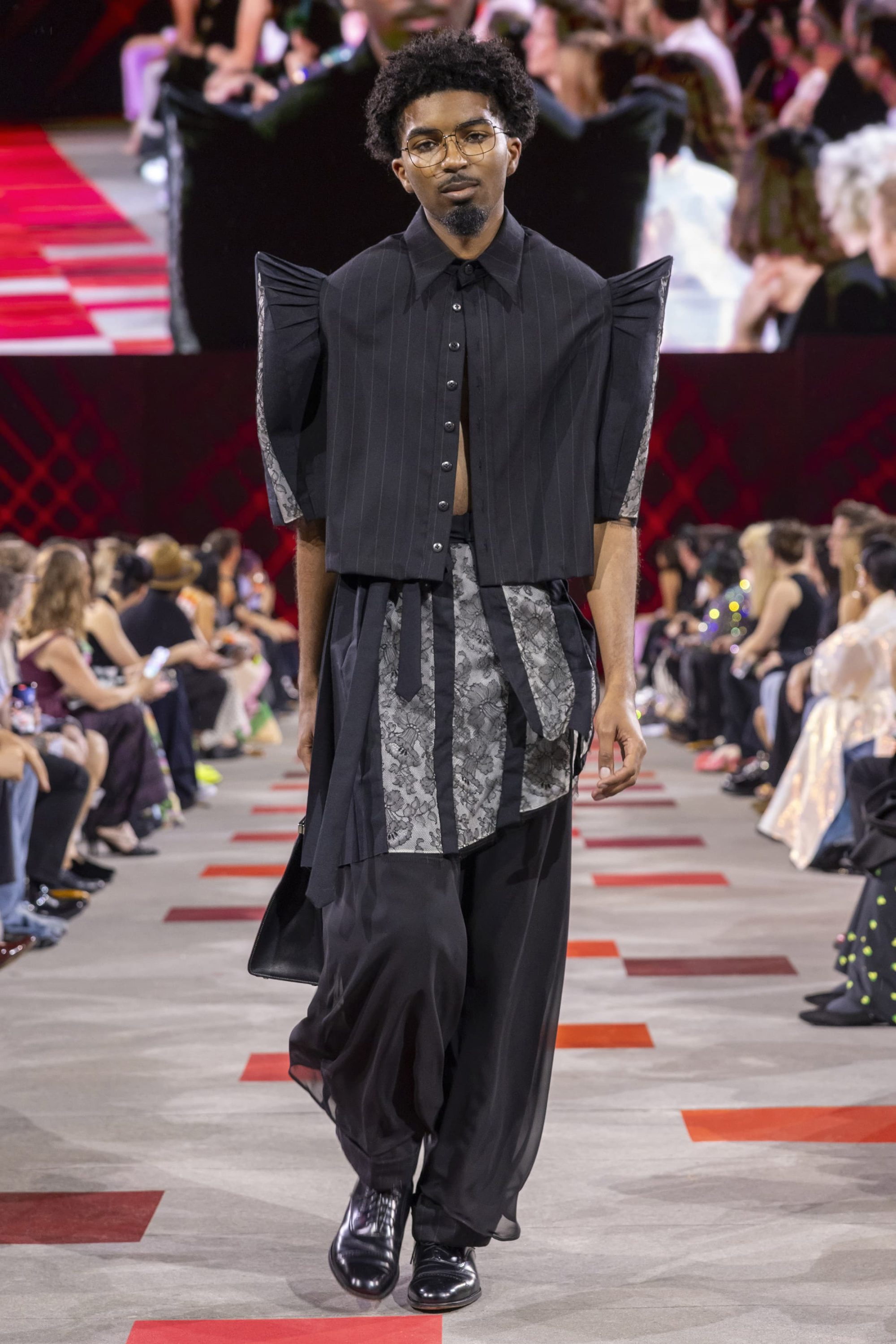
Kagan McCurnin
What was the primary inspiration behind your latest collection, and how did you translate this inspiration into your designs?
The primary inspiration behind my latest collection was based off of the works of the poet Edgar Allan Poe whom I was named after (Poe is my middle name). I was completely inspired by the dark beauty in his writing and wanted to imbue that within my collection through the color palette, design, construction, and accessories. After researching the Edwardian period (the period that Edgar Allan Poe lived in), I want to use similar silhouettes from that era as well as other trending fashions during that period such as long skirts, the voluminous sleeves, accents of lace, and intricate details. I also wanted to incorporate more of who I am in this collection by creating my own family tartan. With an Irish/Scottish last name, there is normally a family tartan to signify what clan (family) you are from, but for my family (McCurnin) there was no tartan for us. So, I decided to create my own tartan starting with a fabric manipulation that is an amalgamation of tartans and lace that is the common fabric seen throughout my collection.
Can you describe the core elements of your brand DNA? What unique aspects define your design aesthetic and differentiate your brand from others?
My design aesthetic is based on a natural approach with hands-on creating. I choose to start designing through what inspires me and most of the time it comes from nature, poetry, music, places. I just create physical mood boards and collages working out every aspect and seeing if the creative spark carries through inspiring more and more. My process of creating with ink or charcoal to paper helps me bring designs alive from my head through my hands rather than solely using Procreate or CLO; however, I did use some technical software as part of making mood boards, customer boards, etc. But I have been drawing my own designs and such since I was a child, so the use of pen to paper only feels natural for me. As the design and brainstorm continues, having the tactile element allows for multiple ideas to be poured out and either are kept or segmented and redefined. In my opinion, having that human touch within each design whether it be how you balance the color in the sketch or the stroke one uses to define the flow of a skirt can have a huge impact on the design itself and possibly inspire more design from it. I want to design with intention. Who am I designing for and why? In this collection, I created a beautiful womenswear line keeping the average woman in mind, and in my belief the average woman has occasions that she wants to get dressed up for and stand out. Are the designs a bit daunting? Yes. But they are still approachable for everybody, every body type, and any age.
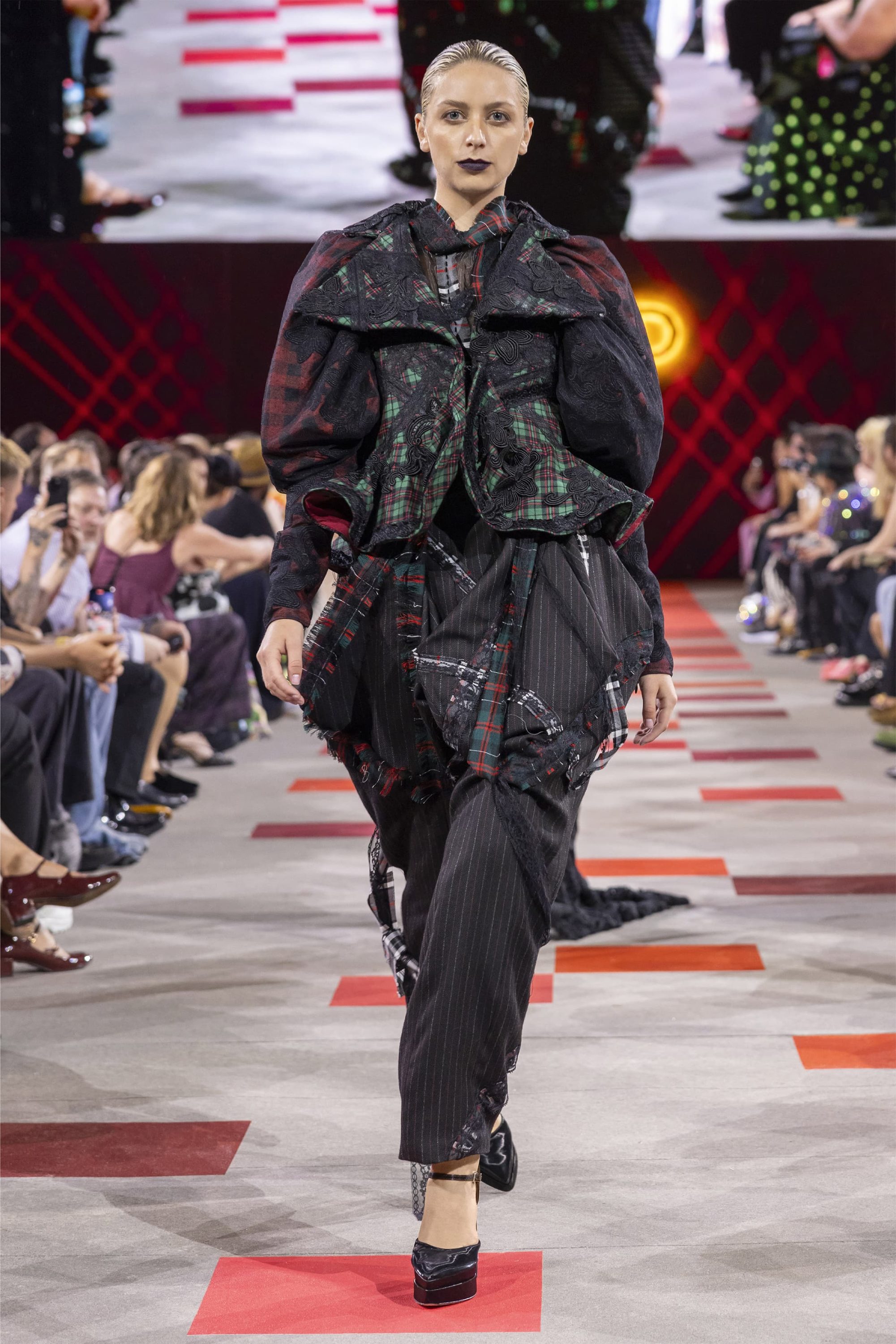
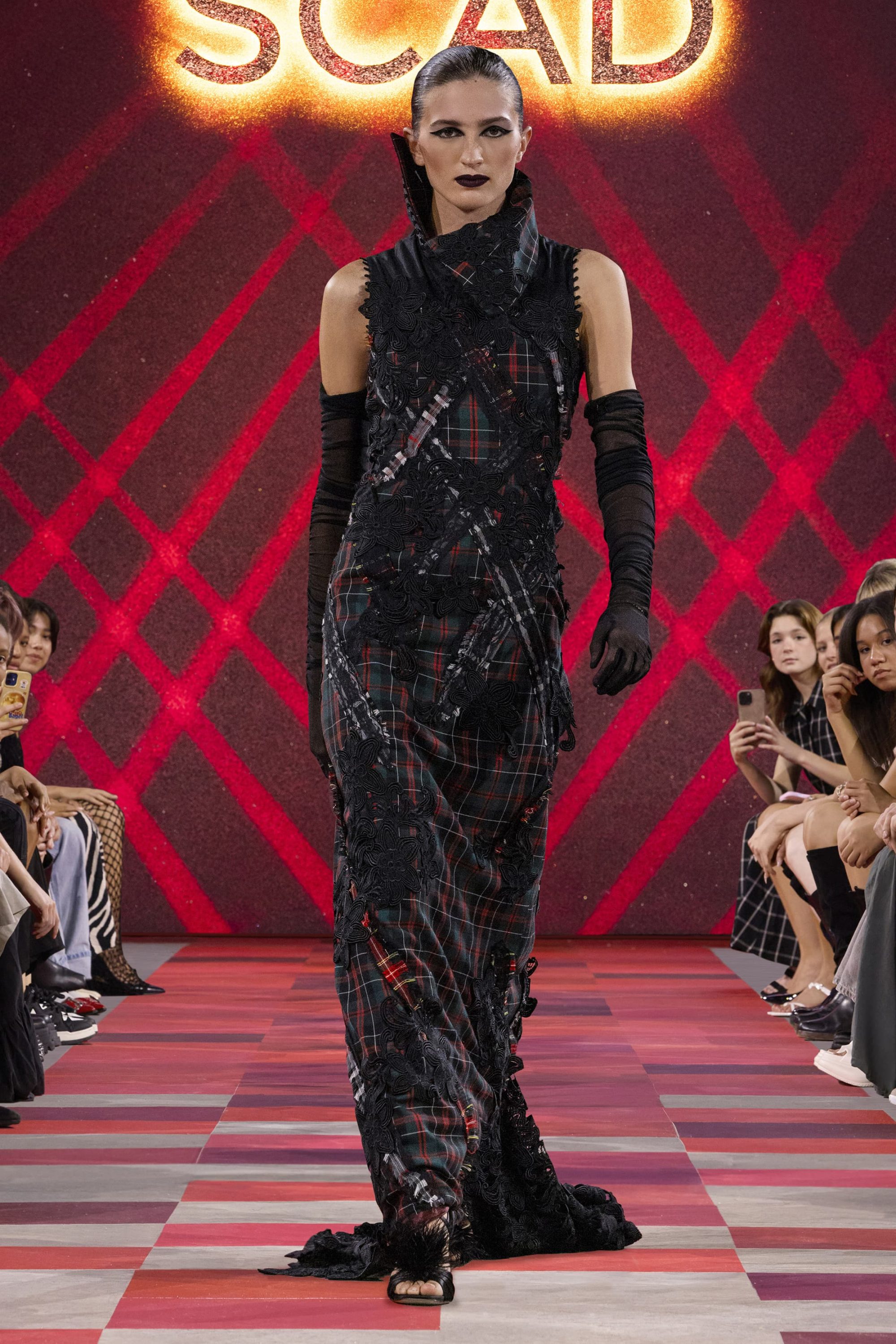
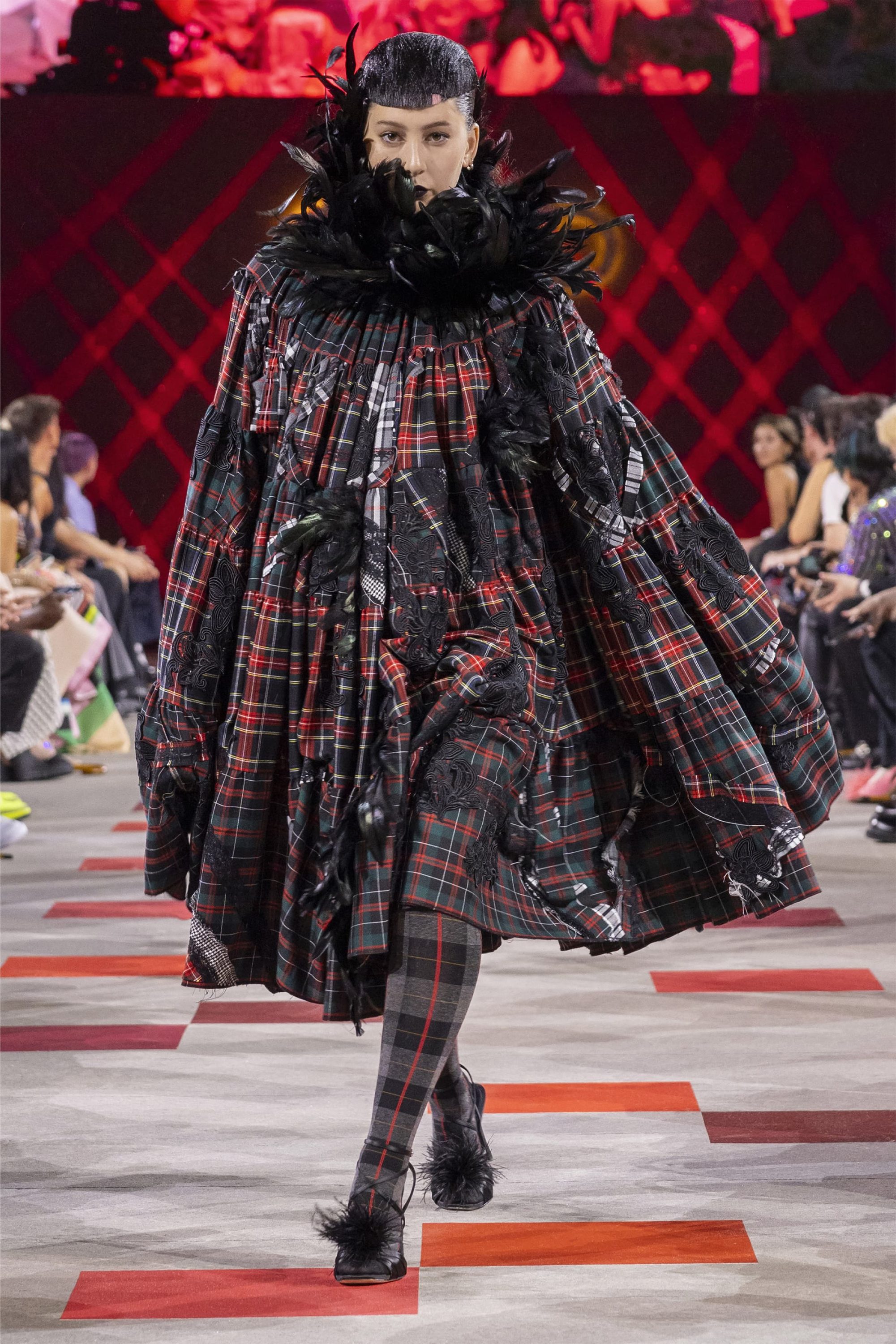
Andrea Rios
What was the primary inspiration behind your latest collection, and how did you translate this inspiration into your designs?
My last collection, Maria Julia, is a tribute to my personal journey and Peruvian heritage. It’s a way for me to connect with my roots and honor the important women in my life, particularly my mother, Maria Julia, after whom the collection is named. The collection is also influenced by my muse, the legendary Peruvian opera singer Yma Sumac, whose captivating voice and heritage have left a profound mark on my creative expression.
Can you describe the core elements of your brand DNA? What unique aspects define your design aesthetic and differentiate your brand from others?
The most essential aspect of my collection is that it is very personal. I talk about my family, my mom, my grandmother, my dad, and my own experiences in life. My designs represent me; they tell my story from a very personal point of view.
I also think that who I am now may be different from who I will be as time and life go on. We are in constant change, and I think that it is important to stay open to new possibilities, new ideas, and different creative perspectives as I grow as an artist and designer.
